Publications

Below is a list of all our current in house publications, all of which are in print and can be purchased (see below for order forms).
For all our bibliographic references click here or to view in word (.doc) format click here.
All publications are available to purchase as paperback and/or PDF. For pricing see each individual publication.
To download the Monograph order form (word.doc) click here or pdf format click here
To download the Occasional Paper order form in (word.doc) click here or or pdf format click here
Bulk buy offers
Buy any 10 or more PDF volumes and get 20% discount on purchase.
Buy any 5 or more paperback volumes, get 20% discount on purchase (discount does not include postage and packaging).
If you are buying more than 10 paperback volumes, please enquire at [email protected]
Occasional Papers

Occasional Paper 1: Medieval Occupation at RAF Quedgeley, Gloucestershire
Occasional Paper 1 presents the results of archaeological excavations at the site of the former RAF Quedgeley, Gloucestershire. The archaeological potential of the area was confirmed by field evaluation comprising both geophysical survey and trial trenching, being just north of the Scheduled medieval moat at Manor Farm. Excavation revealed a sequence of occupation dating from the 11th century AD through to the 18th, with a farmhouse rebuilt several times between the 11th and 15th centuries. One notable interest of the site lies in the evidence of pottery supply to a rural community over this long time span. There is also limited evidence for Iron Age and Roman occupation in the area.
A4 soft cover, 22pp, illustrated throughout including 3 colour plates.
ISBN 978-0-9561974-7-4
Paperback (+ PDF if requested) £13.00 (+postage and packaging)
PDF £13.00
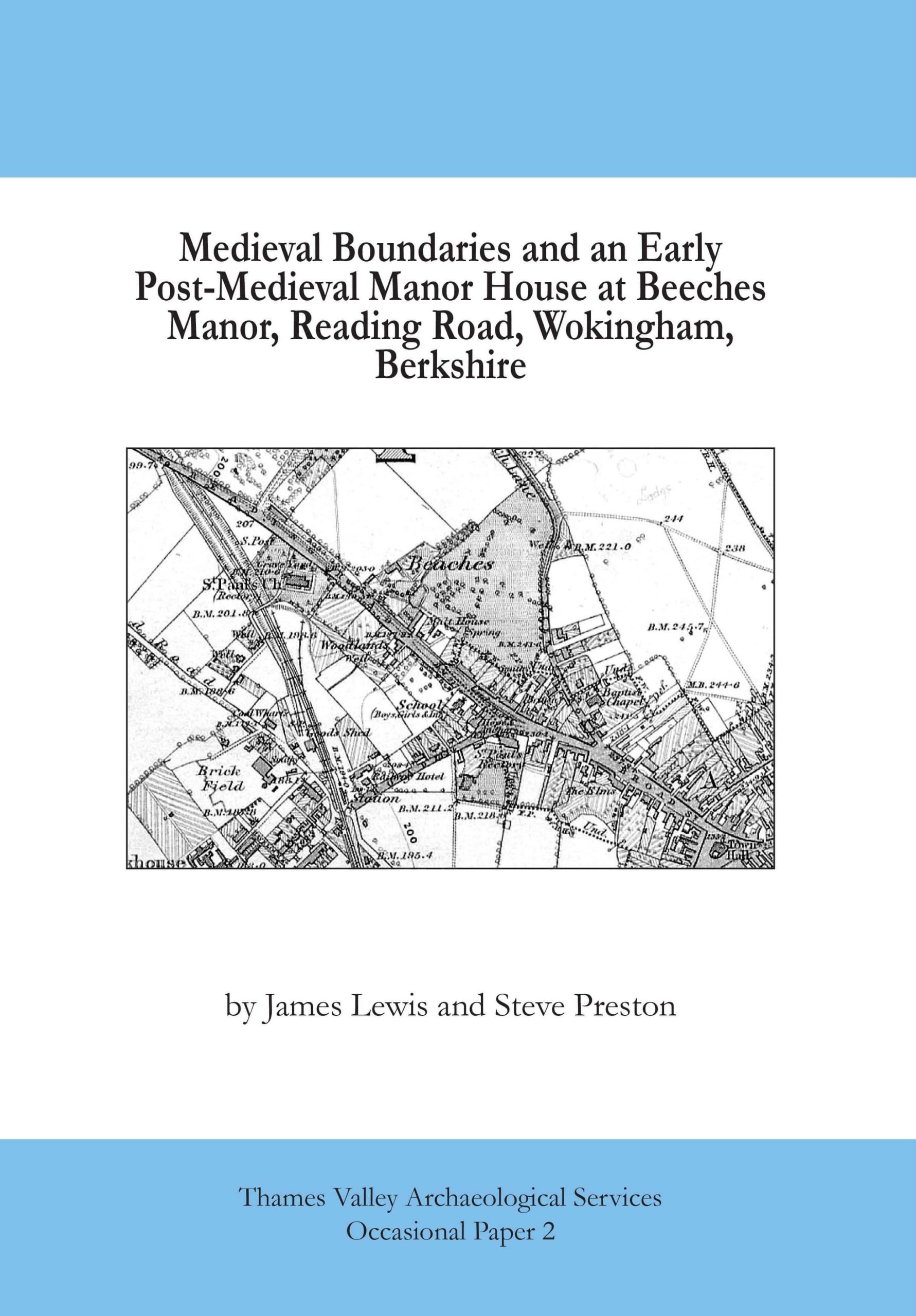
Occasional Paper 2: Medieval Boundaries and an early Post-medieval Manor House at Beeches Manor, Reading Road, Wokingham, Berkshire
Excavations on the site of Beeches Manor revealed evidence for medieval, early post-medieval, and 19th–20th century occupation. The medieval occupation is represented only by enclosure ditches and a pit, over a time span which the pottery chronology is unable to help refine between the 11th and 15th centuries. A substantial house on the site, perhaps dating from the early 17th century, is known to have formed the core of a building destroyed by fire in 1961. This may be supposed to have been built by alderman John Whitlock, who owned the manor at least by 1628. Cartographic evidence from the 18th and early 19th century shows a larger complex of buildings on the site which included a brewhouse. The central portion of this house survived while the remainder of the complex was comprehensively demolished between 1817 and 1830. The core of the house was then extended and the gardens were re-landscaped, either at the same time or at least prior to 1909, to include a sunken lawn, a pond and several outbuildings, greenhouses and cisterns/wells.
A4 soft cover, 26pp, illustrated throughout including 11 colour plates.
ISBN 978-0-9561974-8-1
Paperback (+ PDF if requested) £13.00 (+postage and packaging)
PDF £13.00
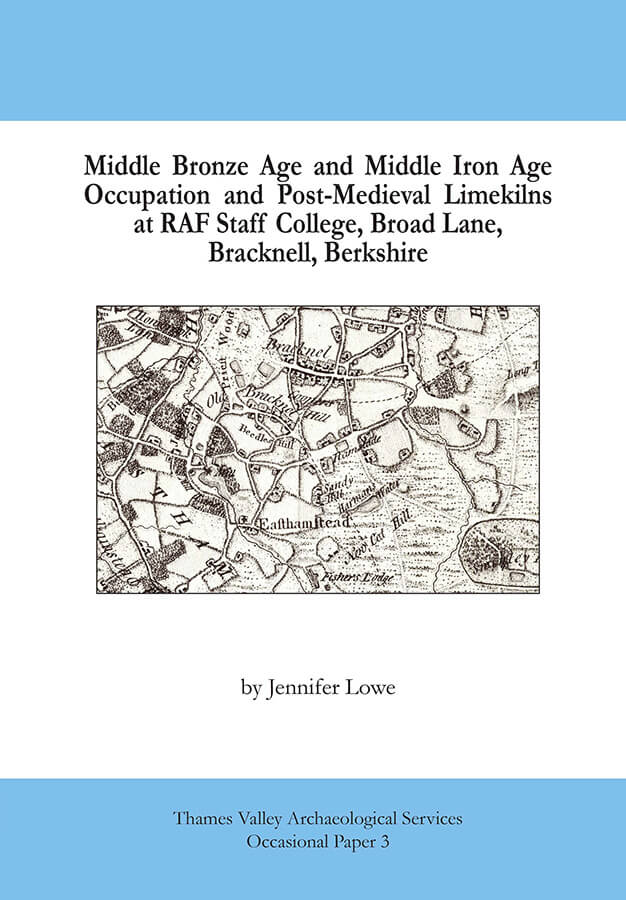
Occasional Paper 3: Middle Bronze Age and Middle Iron Age Occupation and Post-medieval Lime Kilns at RAF Staff College, Broad Lane, Bracknell, Berkshire
An excavation within the grounds of the former RAF Staff College site, Bracknell revealed a number of features ranging in date from middle Bronze Age to post-medieval. Two phases of prehistoric activity were recorded: the middle Bronze Age represented by pits; and the middle Iron Age represented by pits, two ring gully structures, dated by radiocarbon, and field boundaries. A few sherds of medieval pottery point to only slight use of the site at this time. Much more activity was recorded for early post-medieval times with various ditched boundaries and pits, and an area of industrial activity dating from the mid 16th to 17th century which comprised two lime kilns and a well and may relate to the production of mortar for construction of Ramslade House which formed the original Staff College.
A4 soft cover, 24pp, illustrated throughout including 2 colour plates.
ISBN 978-0-9561974-9-8
Paperback (+ PDF if requested) £13.00 (+postage and packaging)
PDF £13.00
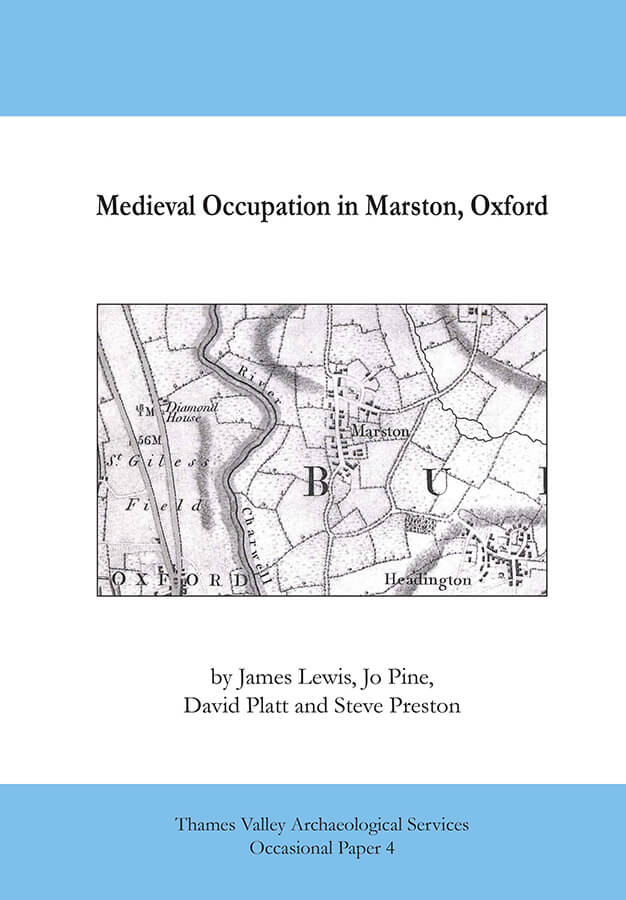
Occasional Paper 4: Medieval Occupation in Marston, Oxford
Marston, just to the north-east of Oxford, has seen little formal archaeological investigation. Over the winter of 2012/13, two small excavations side by side revealed a surprising density of medieval pits and ditches, giving the first indications of the medieval layout of the village, with origins apparently in the 12th century, and little that need be later than the 14th century. There appears to be a distinct break in occupation through the 15th century before a modest revival in the 16th. Although the areas investigated were relatively small, and no structural remains were encountered, the north-eastern edge of the settlement seems to have been established, in much the same position as it was mapped in the late 18th century: the boundary ditches excavated here bounded an area that contained pits to the south and west and no features to north and east.
A4 soft cover, 21pp, illustrated throughout including 8 colour plates.
ISBN 978-0-9926330-0-4
Paperback (+ PDF if requested) £13.00 (+postage and packaging)
PDF £13.00
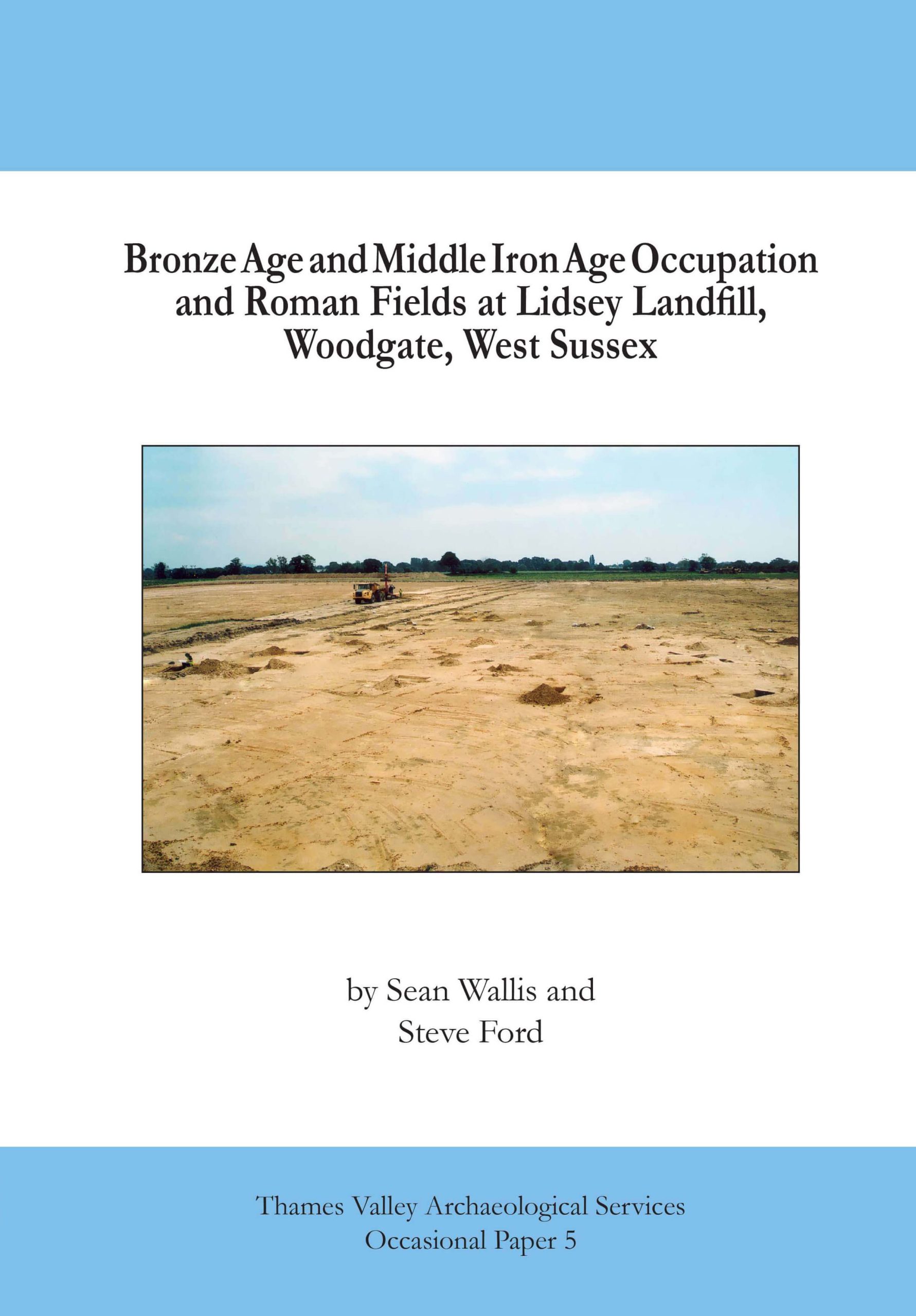
Occasional Paper 5: Bronze Age and Middle Iron Age Occupation and Roman Fields at Lidsey Landfill, Woodgate, West Sussex
Evaluation trenching and subsequent open area excavation were undertaken in advance of expansion at Lidsey Landfill in West Sussex. The fieldwork revealed predominantly prehistoric occupation with the Middle Bronze Age through to Middle Iron Age being the principal periods represented by clusters of pits and postholes followed by enclosures and small areas of fields. The area was overlain by a series of Roman field boundaries which commenced early in the Roman period but had gone out of use by later Roman times. Subsequent activity was only represented by a few sherds of early Saxon pottery, a medieval pit and post-medieval and modern field boundaries.
A4 soft cover, 44pp, illustrated throughout including 10 colour plates.
ISBN 978-0-9926330-4-2
Paperback (+ PDF if requested) £13.00 (+postage and packaging)
PDF £13.00

Occasional Paper 6: Medieval Haddenham, Buckinghamshire: Excavations at Townsend and Fort End, 2011 and 2013
This paper details the findings of two excavations undertaken at locations within Haddenham. The first of these, at 5 Townsend, was conducted in 2011 and uncovered evidence of the development of the late Saxon and medieval village. The findings showed that this period of occupation was followed by a time of abandonment before reuse in the post-medieval period. Residual pre-Saxon finds hint at the sporadic use of the site in earlier periods. The second excavation was undertaken at 2 Fern Lane, Fort End in 2013. Here the digging revealed a series of linear ditches of an 11th - 12th century date which most likely represent a property boundary relating to a 'croft'. This boundary was redefined several times before being abandoned in the 12th century, much earlier than the commonly observed phases of abandonment in the 14th century Haddenham and elsewhere.
A4 soft cover, 36pp, illustrated throughout including 11 colour plates.
ISBN 978-0-9926330-5-9
Paperback (+ PDF if requested) £13.00 (+postage and packaging)
PDF £13.00

Occasional Paper 7: Medieval Settlement at Oak Farm, Milcombe, Banbury, Oxfordshire: Excavation in 2012
An excavation at Oak Farm has explored a component of the medieval settlement at Milcombe. Occupation appears to have commenced in the 11th century, perhaps within the late Saxon period with the construction of a droveway. The manor of Milcombe was mentioned in Domesday Book in 1086. Subsequent phases of use in the 11th-13th century included the presence of rectangular post-built structures. These were eventually replaced by stone-founded buildings in the 13th to 15th centuries which also included a probable dovecote. Evidence of use in the early post-medieval period is rather slight but the site become incorporated within the Oak Farm complex in the 19th century.
A4 soft cover, 23pp, illustrated throughout including 7 colour plates.
ISBN 978-0-9926330-6-6
Paperback (+ PDF if requested) £13.00 (+postage and packaging)
PDF £13.00
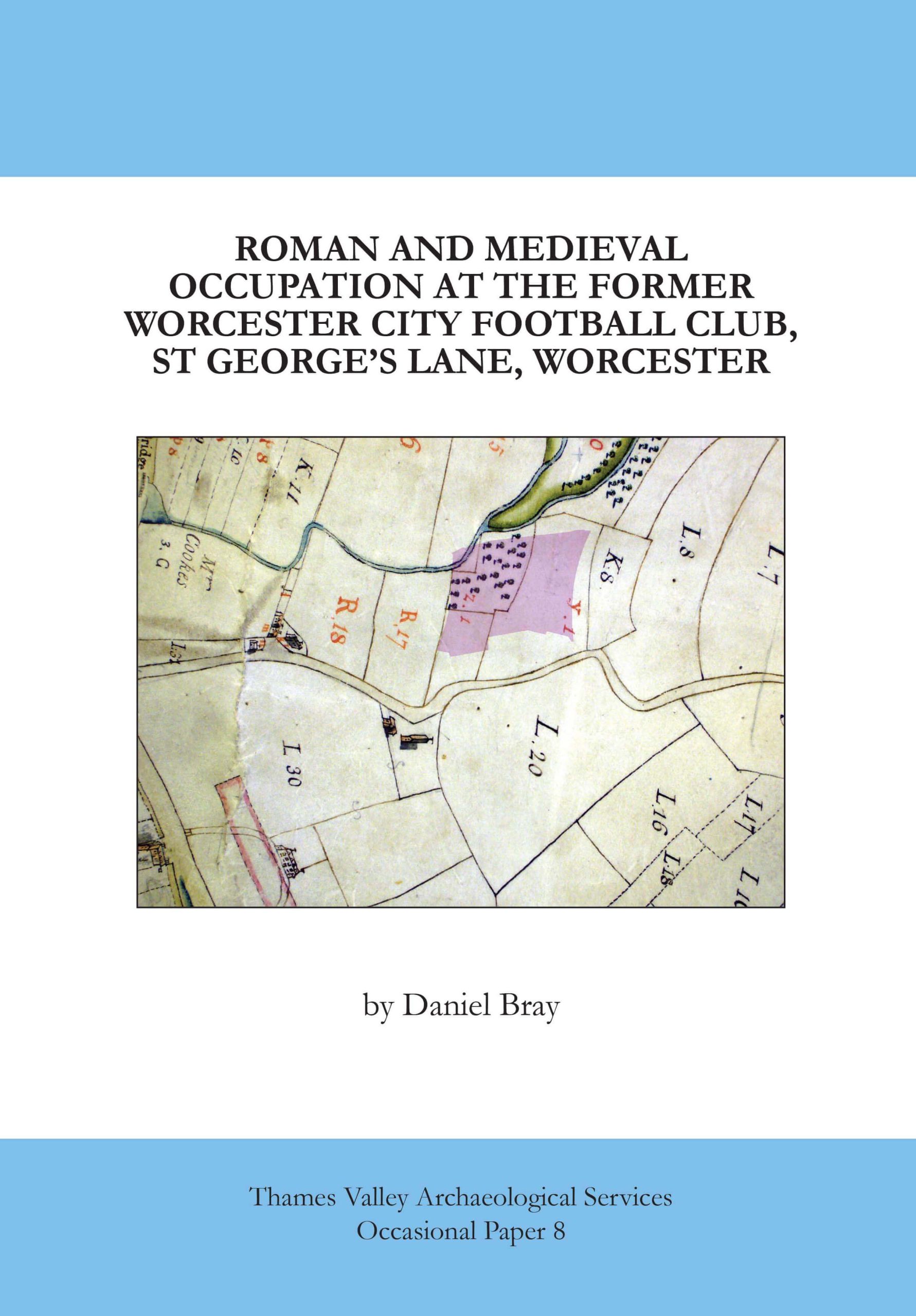
Occasional Paper 8: Roman and Medieval occupation at the former Worcester City Football Club, St George's Lane, Worcester
A small area excavation revealed a dense cluster of multi-period archaeological deposits ranging from (probably) the Iron Age, Roman, medieval and post-medieval periods. A single un-urned cremation burial is only very tentatively dated to the late Iron Age, but could equally be Roman. The site primarily comprised large boundary ditches, with a minimum of three reorganizations of the layout in the Roman period. Although a small number of pits and postholes were identified, and a moderate quantity of Roman tile, no associated structures were revealed, but the presence of this material suggests a building in the near vicinity. Large quantities of iron smelting slag and fragments of furnace lining suggest that iron production was occurring on or near to the site with a minimum of two furnaces implied. No furnace remains were present within the area examined.
A4 soft cover, 26pp, illustrated throughout including 8 colour plates.
ISBN 978-0-9926330-8-0
Paperback (+ PDF if requested) £13.00 (+postage and packaging)
PDF £13.00

Occasional Paper 9: Middle/Later Bronze Age Occupation at Manor Road, Burgess Hill, West Sussex
A small excavation was carried out in advance of a housing development on the outskirts of Burgess Hill, following an earlier evaluation which revealed several Bronze Age features. The excavation uncovered an unenclosed occupation site radiocarbon dated to the middle to late Bronze Age and a possible cremation burial pit. While sites of this period are relatively common on the chalk downlands and coastal plain of Sussex, they are extremely rare on the claylands of the Weald. Two features were notable for the large number of clay loomweights they contained.
A4 soft cover, 22pp, illustrated throughout including 3 colour plates.
ISBN 978-1-911228-02-8
Paperback (+ PDF if requested) £13.00 (+postage and packaging)
PDF £13.00
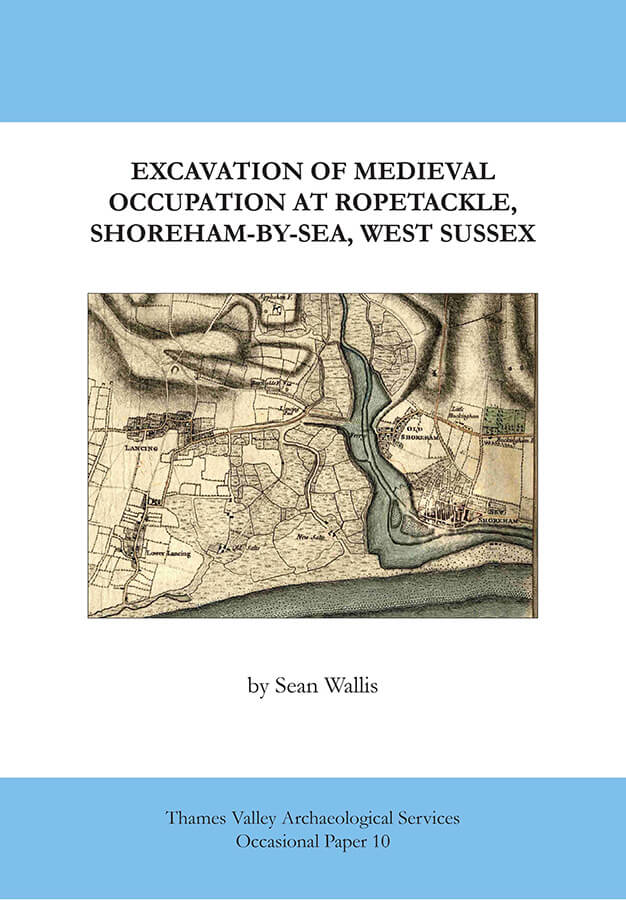
Occasional Paper 10: Excavation of Medieval Occupation at Ropetackle, Shoreham-by-Sea, West Sussex
Archaeological excavation on High Street, Shoreham-on-Sea, West Sussex revealed new evidence for the development of the town. Apart from a few stray finds of prehistoric struck flints, the site and adjacent areas were first lightly used in late Iron Age and early Roman times. No further use is documented until the late 12th century, when the formation of New Shoreham is historically documented. The site is then well used during the 13th and 14th centuries for domestic occupation activities, perhaps as a part of a single, large landholding. In common with many other medieval settlements across England this use comes to an abrupt end in the late 14th century, an observation easier to make than explain, though epidemic disease, economic decline or, for a coastal town, naval warfare, may all have their part to play. Sustained reuse was not to take place until 19th-century terraced houses were built, followed by a cinema, car show room, and latterly, the residential accommodation which necessitated the excavations described below. This paper includes reports on modest but significant assemblages of pottery and animal bones (among other finds). The quantity of ship nails among the metal finds suggests ship-breaking was among the activities on the site or nearby.
A4 soft cover, 26pp, illustrated throughout including 7 colour plates.
ISBN 978-1-911228-03-5
Paperback (+ PDF if requested) £13.00 (+postage and packaging)
PDF £13.00

Occasional Paper 11: Medieval and Post-medieval Occupation at 47 Endless Street, Salisbury, Wiltshire
An archaeological excavation in central Salisbury revealed continuous occupation from the 13th century to modern times. Several standing walls were constructed from chalk blocks and formed a two-cell shaft-and-pit garderobe of High Medieval date. This was replaced by a later medieval well and truncated by a post-medieval boundary wall. The disuse fills of the garderobe, as well as clusters of intercutting cess or rubbish pits, of later medieval date, contained valuable information on the site's economy and the inhabitants' diet. A single sherd of late Bronze Age pottery recovered from a heavily truncated pit within a pit cluster may be indicative of limited prehistoric activity in the area. The site is considered to represent a single back-yard plot in the medieval period, sub-divided in post-medieval times. This Occasional Paper contains reports on locally significant stratified and well-dated assemblages of pottery, metallic finds, animal bones and plant remains which will form a baseline for future research into the medieval city, whose archaeology, has previously been surprisingly patchily documented.
A4 soft cover, 22pp, illustrated throughout including 13 colour plates.
ISBN 978-1-911228-05-9
Paperback (+ PDF if requested) £13.00 (+postage and packaging)
PDF £13.00

Occasional Paper 12: A Middle Bronze Age Pit Circle and Field System, and Roman Settlement at Hitches Lane, Fleet, Hampshire
Archaeological excavations were carried out in advance of development in five areas at Hitches Lane, Fleet. Of special interest was the prehistoric activity: a 42m diameter pit circle and land division of Middle Bronze Age date. Finds were relatively few, but the chronology is supported by three radiocarbon dates. The largest of the excavation areas also contained a substantial 2nd-century Roman rectangular timber-framed building set within a system of fields and paddocks, which was remodelled around the middle of the 3rd century. A substantial furnace was located within this building, and a smaller one outside the structure. The building fell out of use in the early 4th century. A post-built circular Roman building was also recorded. The final phase of activity consisted of an earlier system of land allotment than that depicted on the earliest Ordnance Survey maps of this area.
A4 soft cover, 22pp, illustrated throughout including 13 colour plates.
ISBN 978-0-9926330-8-0
Paperback (+ PDF if requested) £13.00 (+postage and packaging)
PDF £13.00
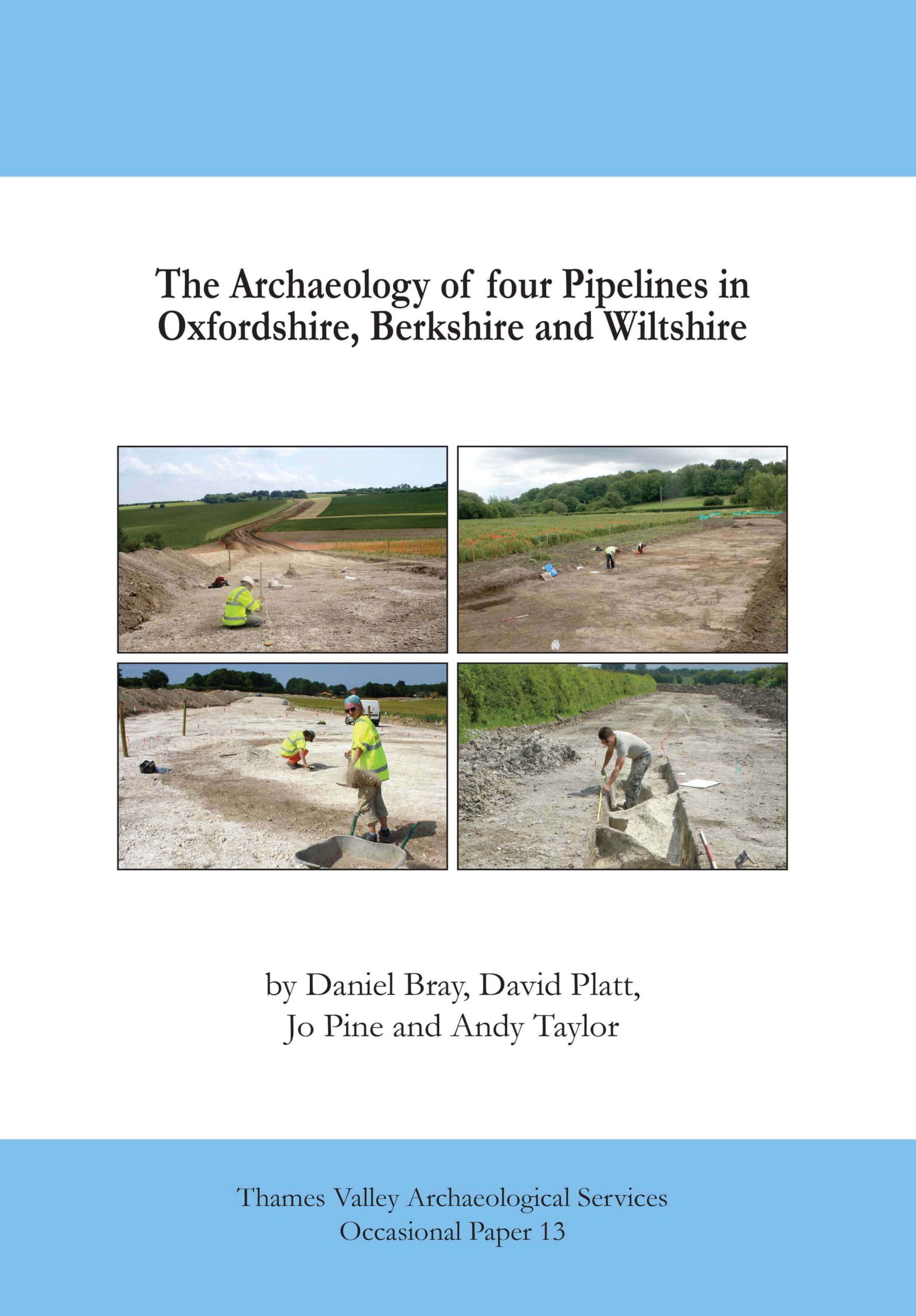
Occasional Paper 13: The Archaeology of four Pipelines in Oxfordshire, Berkshire and Wiltshire
This paper details the findings of recording actions undertaken during the stripping of four pipeline routes in Oxfordshire, West Berkshire and Wiltshire. Observations along a water pipeline route between Baydon Water Tower and Bailey Hill Reservoir on the Wiltshire/West Berkshire border recorded a Beaker-period pit; a possible Late Bronze Age enclosure; an undated lynchet possibly belonging to a ‘Celtic’ field pattern; part of the ‘Near Down ditch’ linear earthwork (also undated); and, most significantly, two overlapping Late Bronze Age post-built roundhouses. The second, located on the Kennet floodplain at Chamberhouse Farm, Crookham Common, Thatcham, recorded a complex series of palaeohydrological deposits on the floor of the Kennet Valley. These were overlain by a series of early Roman occupation deposits and, subsequently, medieval and post-medieval drainage ditches.
Excavations on an easement in advance of pipe laying between Moulsford and Streatley on either side of the Oxfordshire/West Berkshire border revealed a Bronze Age ring ditch and two pit clusters of late Bronze Age date. Two possible boundary ditches of early Iron Age date were also found. The final site is located on the Kingston Stert to Chinnor pipeline in eastern Oxfordshire. Here segments of two occupation sites of early and middle Roman date have been identified along with areas containing organised landscape features (field boundaries) also of Roman date. Isolated features of Bronze Age were also noted with one Bronze Age pit possibly having been involved in pottery production.
A4 soft cover, 22pp, illustrated throughout including 18 colour plates.
ISBN 978-1-911228-07-3
Paperback (+ PDF if requested) £13.00 (+postage and packaging)
PDF £13.00

Occasional Paper 14: Two Roman Occupation Sites near Swindon: Wanborough and Purton
The two archaeological excavations presented in this volume, at Wanborough to the southeast of Swindon, and Purton to its west, primarily focus on Roman occupation and add to a growing picture of dense rural settlement in this area throughout the Roman period. At Stanley Close, Wanborough, the full extent of settlement was not exposed but the excavated area included enclosures defined by ditches and gullies, with pits and a possible drying oven. The deposits also include a decapitation burial, perhaps that of an old soldier. All seem to date to the middle to late part of the Roman period (later 2nd to 4th centuries AD). The economic evidence suggests a typical mixed agricultural settlement with the usual domesticated animals being raised and consumed on the site, but with an unexpectedly high incidence of horse. Charred plant remains were well represented, with wheat and some barley and oats, being grown and processed on the site.
A few Neolithic or Bronze Age flint flakes along with a small amount of Iron Age pottery and pits suggest some earlier activity in the area. Similarly a few sherds of Saxon and medieval pottery probably reflect use of the site as arable farmland well after the Roman site has gone out of use. At Battlewell, Purton, Roman settlement seems to have been continuous between the 1st and 4th centuries. The early phase included a post-built round house (only partially revealed); the middle Roman phase consisted of pits and a kiln or furnace; but the majority of features belonged to the later Roman occupation, including a rectangular timber building, partial remains of a stone building, a drying oven (pottery- or corn-drier) and a well containing a human burial. Economic data here were less plentiful but probably point to the same mixed subsistence base.
A4 soft cover, 22pp, illustrated throughout including 21 colour plates.
ISBN 978-1-911228-09-7
Paperback (+ PDF if requested) £13.00 (+postage and packaging)
PDF £13.00

Occasional Paper 15: Archaeological Excavations inNorth Hampshire: sites in Basingstoke, Andover and Odiham
This volume brings together the results of archaeological excavations on four sites in northern Hampshire. At Marnel Park, Popley, Basingstoke, ditched enclosures were constructed towards the end of the Iron Age (late 1st century BC or early 1st century AD) and remained in use into the Roman period (early 2nd century AD). The early abandonment adds to a growing picture of rural settlement instability within the Roman period.
The excavation at 55 Chantry Street, Andover, mainly focussed on medieval occupation at what would then have been the edge of the town. The major feature might conceviably have been a mill race or a very substantial ditch, but its interpretation is very uncertain. The site was occupied from the 11th to 14th century but there was a marked lack of 15th- or early 16th-century evidence, until a cottage was built in the late 16th-century.
Two sites on the High Street in in Odiham offer contrasting perspectives on the development of this relatively little explored town. At number 23, an early Roman occupation, probably a farm, does not appear to have lasted long but there was evidence for both middle and late Saxon phases, probably again a farm, with some evidence for ironworking, radiocarbon dated to the 7th century. If occupation extended into the Medieval at all, however, it was surprisingly slight for such a central location. At number 106, in contrast, nothing appears to be earlier than the 13th century, suggesting this date for an expansion of the settled area further east than previously imagined. Again, however, the occupation was short-lived and the town’s growth overall may have been equally so.
A4 soft cover, 97pp, illustrated throughout including 25 colour plates.
ISBN 978-1-911228-12-7
Paperback (+ PDF if requested) £13.00 (+postage and packaging)
PDF £13.00

Occasional Paper 16: Earlier and Later Neolithic Pits, Middle Iron Age Burials and Iron Age and Roman Enclosure at Highbury Avenue, Salisbury, Wiltshire
Despite extensive truncation of the site by foundations and terracing from the buildings of a former school, multi-period remains survived to be excavated. The likely presence of remains on the site had first been recognised by aerial photography before the school was built. The earliest prehistoric activity was represented by single examples of early and middle Neolithic pits. This was followed by Iron Age enclosure and occupation, along with eleven inhumation burials certainly or probably of Middle Iron Age date. Four of the burials were radiocarbon dated to between 376-152 cal. BC. Subsequent occupation continued into the Late Iron Age and early Roman period with the digging of another enclosure ditch. There followed an hiatus until later Roman re-occupation of the site with further ditch digging, probably forming another enclosure.
A4 soft cover, 59pp, illustrated throughout including 10 colour plates.
ISBN 978-1-911228-11-0
Paperback (+ PDF if requested) £13.00 (+postage and packaging)
PDF £13.00
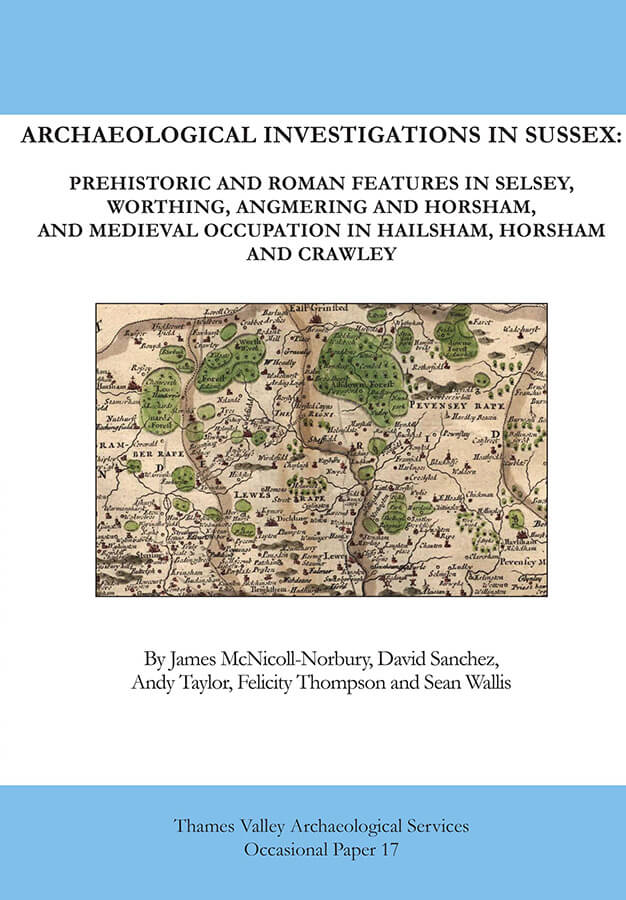
Occasional Paper 17: Archaeological Investigations in Sussex: Prehistoric and Roman features in Selsey, Worthing, Angmering and Horsham, and Medieval occupation in Hailsham, Horsham and Crawley
This collection of shorter papers details the findings of nine small excavations undertaken at locations across Sussex. The volume starts with a cluster of flint- and pottery- rich Earlier Neolithic pits at Worthing, followed by Bronze Age finds at Selsey and Angmering. A single Iron Age roundhouse at Broadbridge Heath, Horsham is notable for the rarity of such sites as yet recorded for the Weald. This is followed by Roman occupation at two locations in Worthing.
The remaining papers belong to the Medieval period, with sites at Hailsham, Barns Green, near Horsham and two sites in Crawley both with evidence of iron production for which the Crawley region is well known.
A4 soft cover, 123pp, illustrated throughout including 42 colour plates.
ISBN 978-1-911228-10-3
Paperback (+ PDF if requested) £13.00 (+postage and packaging)
PDF £13.00
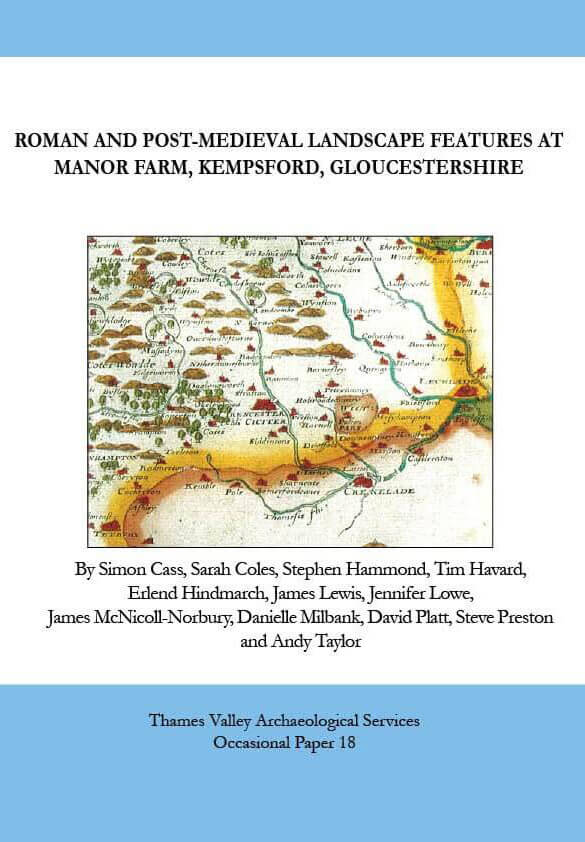
Occasional Paper 18: Roman and Post-medieval landscape features at Manor Farm, Kempsford, Gloucestershire
Over the course of eleven campaigns of archaeological excavation, covering an area approximately 1.5km by 0.5km, several phases of land use were defined. Dating is problematical but both early and late Roman elements can be identified, along with at least two post-medieval phases, and it is considered likely that some features on the site were pre-Roman (Iron Age), including a single, discontinuous boundary some 750m long. It is clear that a large parcel of landscape in the south-west of the site was divided up according to a single scheme in the Roman period, the basic elements of which (a ditched trackway and very large fields) lasted through Roman remodelling and appear to have influenced the post-medieval layout as well. A second, apparently unconnected, Roman field system occupies the north-east of the site. Finds of all kinds were rare and environmental evidence sparse, but molluscan analysis, nearly all from what have turned out to be post-medieval features, suggests the area was damp, perhaps water meadow, throughout that period. The disconnectedness of the Roman landscape elements supports the case for seeing this landscape as parcelled up on a large scale, yet at the same time piecemeal, with a density of a farm every kilometre or so.
A4 soft cover, 115pp, illustrated throughout including 18 colour plates.
ISBN 978-1-911228-15-8
Paperback (+ PDF if requested) £13.00 (+postage and packaging)
PDF £13.00

Occasional Paper 19: Archaeological Excavations on Four Sites in Winchester, Hampshire
This volume brings together the results of archaeological excavations on four small sites in the historic city of Winchester, in Hampshire: two in the historic core of the medieval town, two just on its outskirts.
The periods represented vary from site to site. On Northbrook Avenue in the eastern suburb of St Giles, a Neolithic pit, undated but possibly Saxon burials, and a post-medieval ditch form an eclectic mix. Hazelnut shell from the Neolithic pit provided a radiocarbon date at the beginning of the 3rd millennium cal. BC. A case is made for the ditch (which is not intrinsically well dated) forming part of a Civil War earthwork, as it corresponds with an earthwork mapped as apparently already ancient in 1791.
At Little Minster Street in the heart of the medieval town, early Roman occupation is unexpectedly joined by another Neolithic pit, all sealed by a succession of later Roman and medieval deposits.
At Hyde Abbey Road on the northern edge of the medieval town, a long sequence of land-use begins in the late Saxon period and covers the medieval and early post-medieval periods, attesting to considerable efforts at drainage on land that was probably farmed from the Abbey and remained susceptible to flooding.
Finally at Southgate Street, there is evidence for an early Roman west-east street surface, medieval buildings and further street surfaces.
A4 soft cover, 88pp, illustrated throughout including 11 colour plates.
ISBN 978-1-911228-16-5
Paperback (+ PDF if requested) £13.00 (+postage and packaging)
PDF £13.00
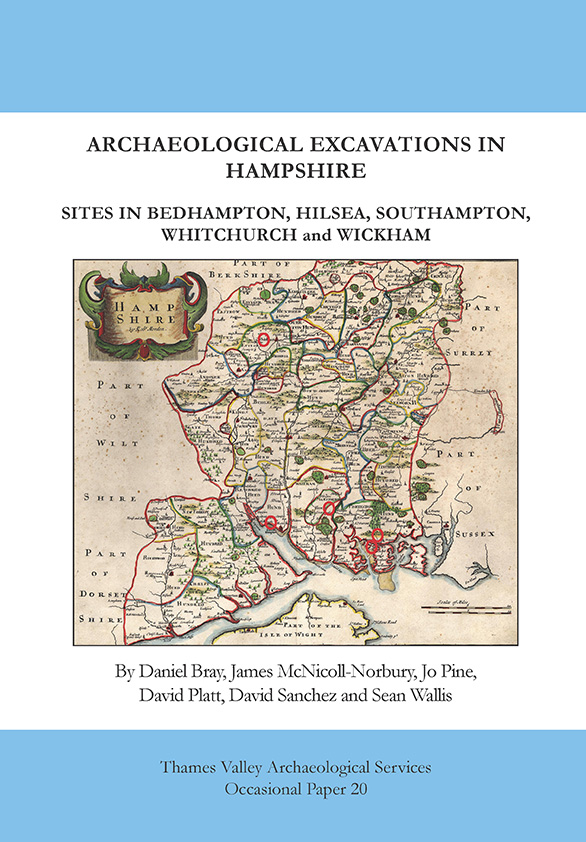
Occasional Paper 20: Archaeological Excavations in Hampshire
Small archaeological excavations on five sites provided varied results from a range of periods. At Scratchface Lane, Bedhampton, a single pit, rich in burnt flint has been radiocarbon dated to the middle Bronze Age. The main finding, however, was an early Iron Age occupation site consisting of two post-built roundhouse structures, a pit cluster, and linear features. No Roman features that might be associated with the projected Roman road to the north were present.
At Peronne Road, Hilsea, in Portsmouth, apart from one gully, which may be Roman, the datable features appear to represent occupation during the mid to late Bronze Age, medieval and post-medieval periods. The investigations provided new evidence for medieval occupation beyond the supposed limits of medieval Hilsea.
From St Mary’s Street in Southampton comes further evidence for occupation within the middle Saxon settlement of Hamwic, succeeded by several phases of medieval occupation, including road surfaces that may be earlier versions of St Mary Street.
At Bloswood Lane Whitchurch two small area excavations examined a collection of Late Neolithic features including a Grooved Ware pit. Most notable, however, was a hollow infilled with burnt flint-rich deposits which may indicate activities similar to those which produced ‘burnt mounds’ which are more typical of the Bronze Age.
Finally at Wickham, there were deposits relating to late Iron Age and Roman occupation, including a trackway defined by parallel gullies which appears to have originated in the late Iron Age but is precisely on the projected line of the Roman road from Chichester to Bitterne, and was still in use in the 2nd century AD. Later pits (3rd century) were dug between the gullies and thus suggest that the road had gone out of use by that time. An unusual sherd of black samian is a notable find amongst the small pottery assemblage.
A4 soft cover, 109pp, illustrated throughout including 25 colour plates.
ISBN 978-1-911228-17-2
Paperback (+ PDF if requested) £13.00 (+postage and packaging)
PDF £13.00

Occasional Paper 21: Archaeological Excavations on Bronze Age, Iron Age, Roman and Medieval Sites in Reading and Wokingham, Berkshire
Archaeological excavations on three sites around the south-eastern perimeter of modern Reading have led to the discovery of unexpected evidence for several periods in the area’s past. At Ridgeway School, a late Bronze Age burnt mound provided two radiocarbon dates and was accompanied by broadly contemporary pits. Occupation continued into the early Iron Age, and was resumed in the late Iron Age or early Roman period and lasted until middle Roman times, with abandonment, in or not long after AD274, being marked by the deposition of a coin hoard which the owner was never able to recover.
At Matthews green Farm, a middle Iron Age farm represented by a roundhouse, perhaps rebuilt twice, an animal pen, and a few pits was occupied for, probably, a short period around 400BC. Its inhabitants were engaged in iron production as well as farming. In the Roman period, occupation took place on a new site to the north, but again seems to have been a modest, largely self-sufficient farm. A surprising result of radiocarbon dating was the discovery that pits which had been considered to be charcoal clamps related to the Iron Age iron production were in fact medieval.
At Croft Road in Spencers Wood, the more modest discovery of a middle Iron Age field system is nevertheless also of some interest as here, as with all three sites, the chronology is supported by a programme of radiocarbon dating.
An extensive list of the monetiform objects recovered during the excavation can be downloaded by clicking the following Link
A4 soft cover, 79pp, illustrated throughout including 20 colour plates.
ISBN 978-1-911228-18-9
Paperback (+ PDF if requested) £13.00 (+postage and packaging)
PDF £13.00

Occasional Paper 22: A Bronze Age Cemetery and Field System, and Iron Age Occupation at Downton Manor Farm, Downton, Hampshire
This paper combines the results of archaeological excavations between 2010 and 2015, by Thames Valley Archaeological Services and Southern Archaeological Services, at Downton, near Milford-on-Sea, Hampshire. A combination of fieldwalking, geophysical survey and trial trench evaluation over a large area (18ha) in advance of mineral extraction had suggested that the site held only moderate archaeological interest, but excavation revealed a concentrated area of archaeological interest in the north-east corner.
The earliest features were a series of ditches with rectilinear plan, thought to represent a middle Bronze Age organized landscape. This was followed by evidence of Bronze Age burial both as ring ditches (levelled burial mounds) and urned cremation burials (although the urns in fact contained very little burnt bone).
Later occupation of Iron Age date included a ditched enclosure, roundhouses, both post-built and ring-gully type, and rare middle Iron Age cremation burial (radiocarbon dated). Other than the (highly fragmented) cremation urns themselves, finds were disappointingly scarce. The chronology of the site is, however, supported by a programme of radiocarbon dating.
A4 soft cover, 47pp, illustrated throughout including 14 colour plates.
ISBN 978-1-911228-19-6
Paperback (+ PDF if requested) £13.00 (+postage and packaging)
PDF £13.00

Occasional Paper 23: Bronze Age, Roman and Early Anglo-Saxon Occupation on Land to the South of Kings Reach, Ditton Park, Slough, Berkshire
Archaeological excavation in advance of construction of Ditton Park Academy has examined a site with a long history of use, from the later Bronze Age through to the medieval period.
The prehistoric phases on the site have proved difficult to date more closely than Bronze Age to Iron Age, but there are hints that phases include Middle Bronze Age, Late Bronze Age and early-middleIron Age. The post-built roundhouses, of which as many as six were found, must represent at least three phases of building which could be later Bronze Age or earlier Iron Age.
A ditched enclosure can be given only a broad Iron Age date, but was recut in the Roman period, which also sees the creation of a second, more regular enclosure. Usually, a site occupied in the Roman period will produce considerably greater quantities of finds than an Iron Age one, but here there was a marked reduction in the amount of pottery. Either the Roman occupation was extremely short-lived, or this area was well away from the core of any settlement.
The more noteworthy results involve the early Anglo-Saxon period. Although represented by just two Sunken Featured Buildings (SFB), and a handful of other features, they produced more finds and more important information. It is the two radiocarbon dates on residues from Anglo-Saxon pottery which are particularly significant with regard to the end of Roman Britain and Anglo-Saxon settlement. The Thames Valley is considered to have been well colonized by the later 5th century. The dating here of two demonstrably Anglo-Saxon artefacts, one to the late 4th century, the other possibly as early, or not much later, are difficult to explain unless Anglo-Saxon colonization is already well underway before the end of the 4th century, still within Roman times.
A4 soft cover, 47pp, illustrated throughout including 9 colour plates.
ISBN 978-1-911228-14-1
Paperback (+ PDF if requested) £13.00 (+postage and packaging)
PDF £13.00
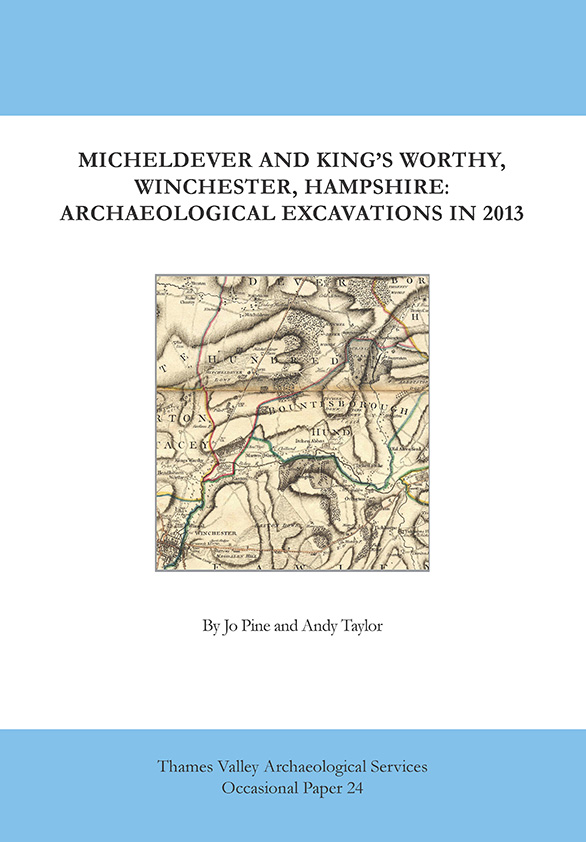
Occasional Paper 24: Micheldever and King's Worthy, Winchester, Hampshire: Archaeological Excavations in 2013
This volume brings together the results of archaeological excavations on two sites to the north of Winchester.
The main report features Saxon, medieval and early post-medieval occupation in Micheldever, where, other than one possible Iron Age pit, the earliest features date to the early-middle Saxon period. Despite a higher density of features in the later Saxon period, no building remains were identified. There is some evidence of iron smithing and quarrying. The medieval occupation spans four phases from the 11th to the 16th century, but with very little evidence after the 14th. An early and long-lived trackway and a field/paddock possibly formed part of a manorial enclosure. A timber-framed building dates to the earliest medieval phase, with more evidence for smithing and quarrying. Nothing indicates especially high status however, and archaeologically visible activity dwindles through the medieval period.
In the 16th century a major change sees buildings and formal gardens probably related to the estate of Thomas Wriothesley, later Lord Chancellor. It has been thought that remains uncovered in the 1970s, immediately to the west, were of Wriothesley’s main hall, so it is possible that the buildings here were outhouses or barns.
A smaller site in King’s Worthy is chiefly notable for its proximity to the sites of Iron Age ‘banjo’ enclosures and a Roman villa, both Scheduled. The excavation provided new evidence for late Iron Age occupation and a small cremation cemetery. A small quantity of Roman pottery recovered from an enclosure ditch suggests it remained open into the early Roman period.
A4 soft cover, 111pp, illustrated throughout including 14 colour plates.
ISBN 978-1-911228-20-2
Paperback (+ PDF if requested) £13.00 (+postage and packaging)
PDF £13.00
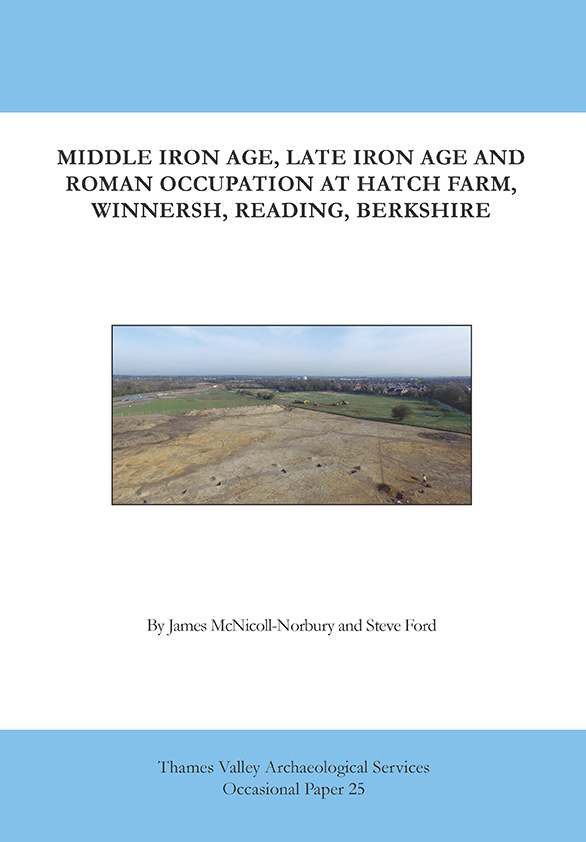
Occasional Paper 25: Middle Iron Age, Late Iron Age and Roman Occupation at Hatch Farm, Winnersh, Reading, Berkshire
This volume presents the results of archaeological investigations over a large area in advance of a major housing development in central Berkshire. Although, under the requirements of the development planning process, increasing attention is being paid to the archaeology of this middle part of the Thames valley, it remains less intensively and extensively explored than either areas upstream or further east.
The excavation of one large, and several small, areas within an overall site of almost 50ha has revealed the presence of middle and late Iron Age and early Roman deposits in the form of field systems and a farmstead, with five round houses and a series of enclosures. Three small square enclosures are of uncertain function and date but may also be middle Iron Age. A reasonably large pottery assemblage is supported by a series of radiocarbon dates, but other artefacts and ecofacts were surprisingly sparse. The site seems to have been occupied from the 5th century BC until the 4th century AD, although it is unclear if this was more or less continuous, or episodic, but at least the Roman phases all appear to build directly upon one another with no obvious sign of discontinuity in layout. The inhabitants do not appear to have been wealthy at any point in this lengthy occupation, but the mere survival of the site for so long runs contrary to a regional trend, which sees few Late Iron Age, much less Middle Iron Age, sites, survive beyond the early Roman period.
A4 soft cover, 77pp, illustrated throughout including 19 colour plates.
ISBN 978-1-911228-23-3
Paperback (+ PDF if requested) £13.00 (+postage and packaging)
PDF £13.00
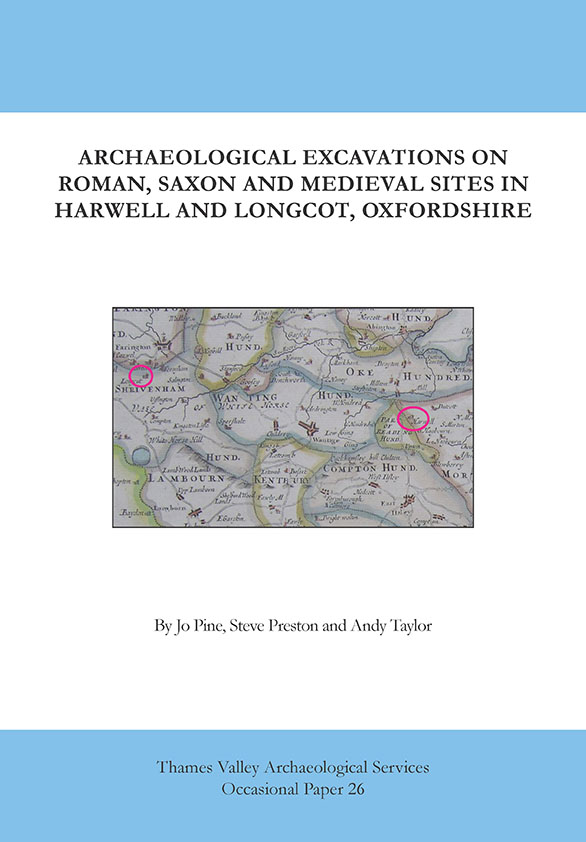
Occasional Paper 26: Archaeological Excavations on Roman, Saxon and Medieval Sites in Harwell and Longcot, Oxfordshire
This volume presents the results from three excavations in the Vale of the White Horse in Oxfordshire: two side by side on Blenheim Hill in Harwell and one in nearby Longcot.
On the larger of the Harwell sites, a series of Roman enclosures and land divisions along with pits, a corn drier and a coin hoard were identified. The site may have been first used as a work-place in the Mesolithic, but the main phases were one early Roman and three late Roman episodes, with an apparent hiatus from the 2nd to early 3rd century. A few sherds of Saxon pottery hint that the last phase continued into the 5th century. Two deposits of cremated human bone (three individuals) were undated but might belong to the early Roman period.
Just across the road, the second excavation found further later Roman enclosures but nothing of early Roman date. Four Middle Saxon inhumation burials, two of which were radiocarbon dated, were located within the area that was possibly still marked by the latest Roman enclosure. A possible Bronze Age pit points to prehistoric activity on the site.
Further west in Longot, the third site revealed a dense sequence of field boundary ditches spanning several phases in the early Roman period (2nd century AD) and early Medieval period (11th–13th centuries AD), with just a few other features (pits and post holes) of both periods. Prehistoric and later Roman activity is reflected only in residual finds. Although no direct (structural) evidence of occupation on the site was found for either period, the quantity of pottery indicates that settlement can be expected not far away. This is the first indication of Roman occupation in Longcot.
A4 soft cover, 111pp, illustrated throughout including 21 colour plates.
ISBN 978-1-911228-22-6
Paperback (+ PDF if requested) £13.00 (+postage and packaging)
PDF £13.00
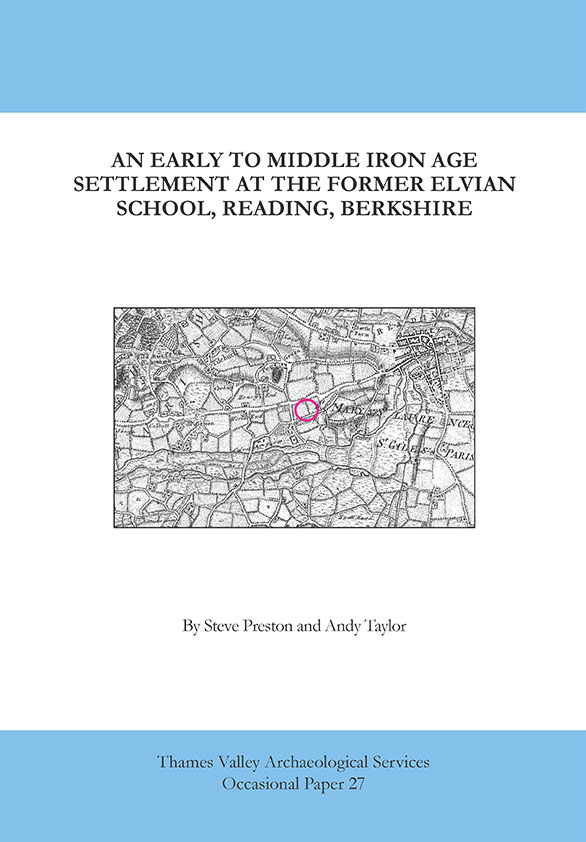
Occasional Paper 27: An Early to Middle Iron Age Settlement at the Former Elvian School, Reading, Berkshire
This volume presents the results from excavations of an Iron Age settlement densely used from at least the start of the 5th century BC through to perhaps the 1st century BC/AD. The early and middle phases on the site are marked by an unenclosed complex of ring gully structures, pits and postholes with little evidence of organized space except for a trackway defined by fences and gullies that was maintained through the whole use of the site and never encroached upon. Several of the ring gullies had been remodelled on three or four occasions and there is clear time depth to the occupation. The ring gullies provided radiocarbon dates commencing in the 5th/4th centuries BC into the 3rd/2nd centuries BC. The part of the site occupied by the ring gullies may have gone out of use in the 1st century BC, to be overlain by an enclosure complex that included the existing trackway which was now defined by more substantial ditches. It is not clear that these late enclosures were occupied.
A single gully was of Middle Bronze Age date and a few struck flints may be of Mesolithic, Neolithic or Bronze Age date. One pit also produced a radiocarbon date in the 8th/7th century BC suggesting that use of the site may have commenced earlier than suggested by the structural evidence. A few sherds of probable Saxon pottery point to a little activity of this period in the area.
The economic evidence recovered was partial with no bone survival, but charred plant remains indicated a typical range of wheat and barley cultivation though there was little evidence for above- or below-ground storage. A little slag suggested small scale smithying on the site.
A4 soft cover, 52pp, illustrated throughout including 16 colour plates.
ISBN 978-1-911228-26-4
Paperback (+ PDF if requested) £13.00 (+postage and packaging)
PDF £13.00
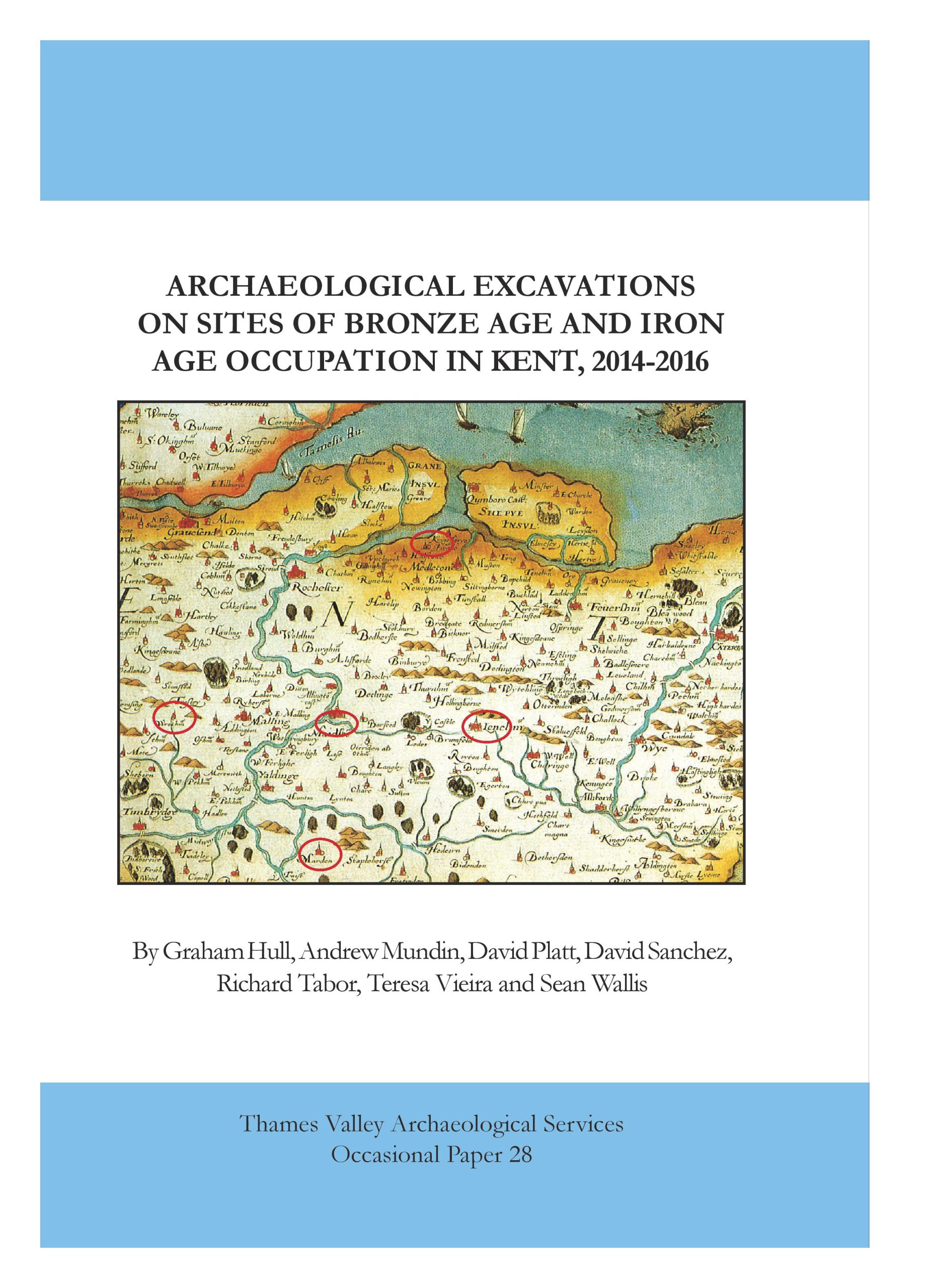
Occasional Paper 28: Archaeological Excavations on Sites of Bronze Age and Iron Age Occupation in Kent, 2014-2016
The five chapters in this volume detail archaeological excavations in advance of development on sites in Maidstone, Marden, Lenham, Iwade and Wrotham, in central and north-western Kent. All five of the sites revealed middle or later Bronze Age features, chiefly pit clusters At Orchard Farm, Iwade, late Iron Age occupation and a small cremation cemetery were also present.
Each of the sites reported in this volume might be considered of only modest significance in itself, but in combination they add to what has until recently been a very patchy record of Bronze Age occupation in north-west Kent. Finds were generally not prolific, although Iwade yielded a fairly substantial pottery assemblage.
Chronologies for the sites at Maidstone and Marden are supported by radiocarbon dates.
A4 soft cover, 85pp, illustrated throughout including 32 colour plates.
ISBN 978-1-911228-27-1
Paperback (+ PDF if requested) £13.00 (+postage and packaging)
PDF £13.00

Occasional Paper 29: Earlier Neolithic Pits and Late Iron Age Settlement at Littleworth Road, Benson, Oxfordshire
housing development on the northern outskirts of Benson, close to the River Thames in Oxfordshire.
The earliest finds were a cluster of four earlier Neolithic pits, two of which were radiocarbon dated to c. 3600–3500 cal BC. They contained a range of flint and pottery finds with charred hazelnut shells but no cereals, along with part of the skull of a child. The Bronze Age was represented by a single Middle Bronze Age pit and a scatter of residual pottery finds.
The main findings dated to the Late Iron Age, when ditches were dug marking enclosures and other boundaries. A rich grave was located outside the enclosures: it (and the nearest enclosure ditch) contained a pottery assemblage with an unexpectedly rich imported (Gallo-Belgic) contribution. Cut features within the enclosures were surprisingly few, suggesting that the site may have functioned as a part of the animal husbandry regime and any more intensively occupied areas were located elsewhere. Unusually, the Late Iron Age settlement did not continue in use into early Roman times. A little Saxon pottery and a Medieval trackway were also recorded.
A4 soft cover, 49pp, illustrated throughout including 19 colour plates.
ISBN 978-1-911228-28-8
Paperback (+ PDF if requested) £13.00 (+postage and packaging)
PDF £13.00
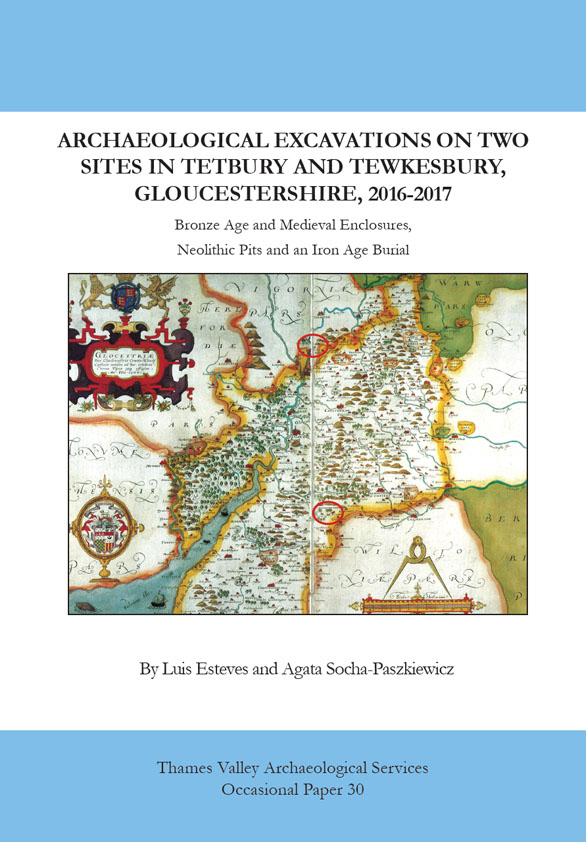
Occasional Paper 30: Archaeological Excavations on two Sites in Tetbury and Twekesbury, Gloucestershire, 2016-2017
This volume details the results of archaeological excavations in advance of development on sites at the northern and southern limits of Gloucestershire.
At Bath Road, Tetbury, a small cluster of pits is probably of early Neolithic date, although the ceramic evidence is somewhat ambiguous. More securely dated is a large L-shaped ditch forming a partial enclosure, which contained Middle Bronze Age pottery and was filling in the third quarter of the 2nd millennium cal BC. A couple of pits also belong to the Middle Bronze Age.
At Bredon Road, Tewkesbury, another group of poorly dated pits is probably Iron Age and associated with the burial of the very incomplete remains of an adult human, radiocarbon dated to the 4th or 3rd century BC. However, most of the features on this site are medieval, perhaps belonging within a relatively short span in the 13th century, and consist of a small ditched enclosure set within a larger, partly open enclosure, probably on, or just beyond, the edge of contemporary settlement.
A4 soft cover, 35pp, illustrated throughout including 18 colour plates.
ISBN 978-1-911228-31-8
Paperback (+ PDF if requested) £13.00 (+postage and packaging)
PDF £13.00
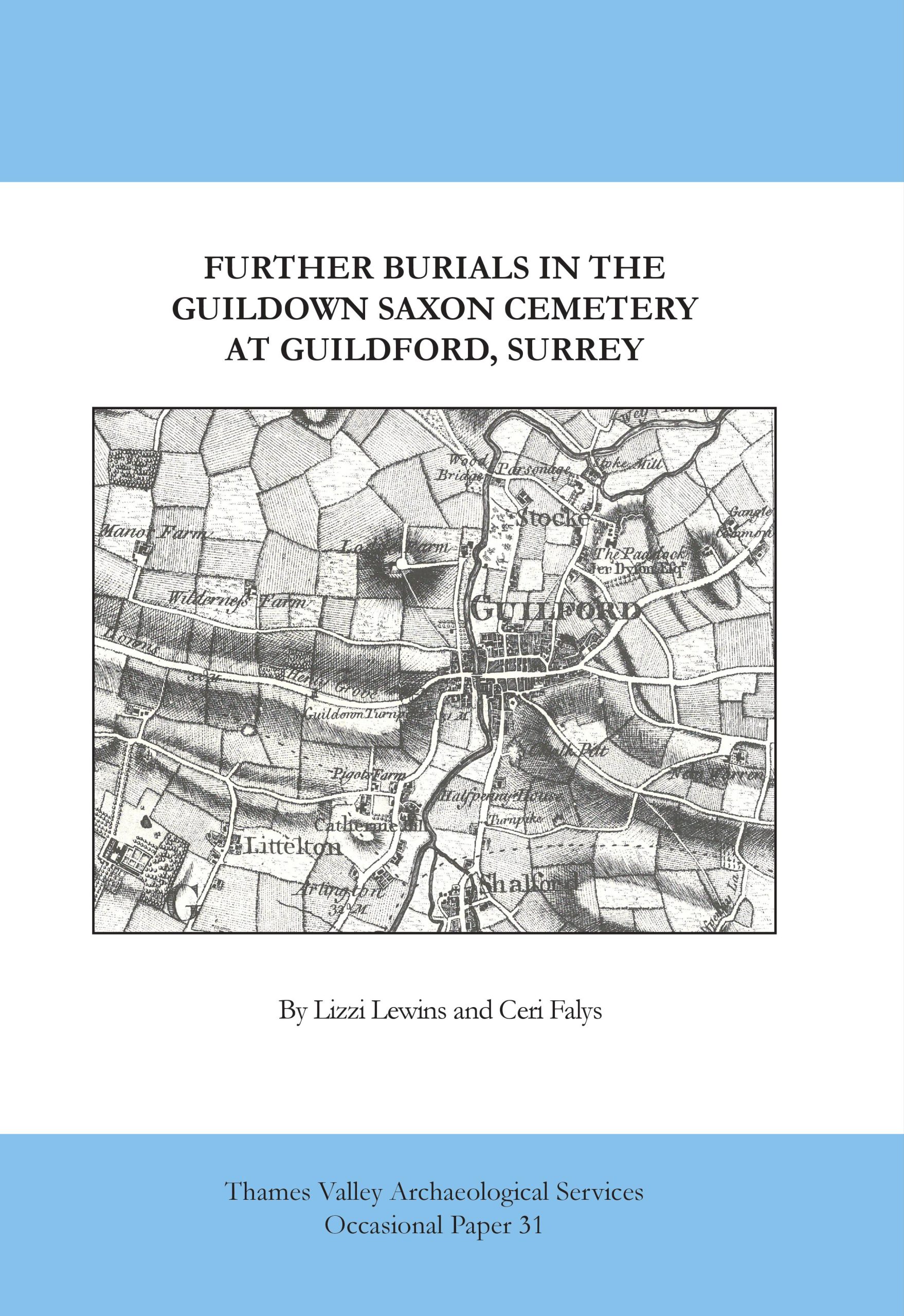
Occasional Paper 31: Further Burials in the Guildown Saxon Cemetery at Guildford, Surrey
A small archaeological excavation explored a new area of the well-known Saxon cemetery, west of Guildford town centre, known as the Guildown 'execution cemetery'. Over 200 burials had been excavated in the early 20th centaury, and the cemetery was already regarded as unusual, yet the application of modern techniques of osteological and isotope analysis has added new components to this intriguing site. Seven graves were exposed, containing the remains of a minimum of 10 individuals. Two phases of burial have been identified, characterized by those displaying the expected furnished early medieval inhumations, and later, non-normative graves. Artefacts and radiocarbon dating indicate an extended period of use, spanning the 6th to 11th centuries AD. The majority of inhumations were buried in supine and extended positions. The exception to this was the unusual inclusion of a semi-disarticulated secondary burial (re burial) of an adult man into a double grave with a younger adult male. Additional in expected observations included the likely prior removal of two skeletons, possibly during previous investigations in the 1920s. Osteological analysis revealed the earliest graves contained a mixed group, including an adolescent and a woman. The later phase of burial comprised solely adult men. No evidence of execution was observed. Isotopic analysis of three men from the later graves suggests that they were not locals.
A4 soft cover, 46pp, illustrated throughout including 21 colour plates.
ISBN 978-1-911228-32-5
Paperback (+ PDF if requested) £13.00 (+postage and packaging)
PDF £13.00

Occasional Paper 32: Iron Age and Early Roman Occupation and a Middle Iron Age Burial at Cheriton Road Sports Ground, Folkestone, Kent
This slim volume details the results of archaeological excavation in advance of development in Folkestone, on the south coast of Kent. The excavation revealed an extensive spread of occupation deposits, with some human burial, dating from the Late Bronze Age through to early Roman times. The earliest features were a single ditch and a possible cremation burial of Late Bronze Age date. The whole of the Iron Age extending into early Roman times seems to have been well represented. The Middle Iron Age dating is supported by a radiocarbon date of 365-164 cal BC. An inhumation burial associated with a second radiocarbon date of 428-353 cal BC was an unusual discovery for this period. A small collection of struck flint includes Mesolithic and possibly upper Palaeolithic material.
The bulk of the site’s activity belongs to the late Iron Age and early Roman period with the creation of ditched field systems and enclosures. A number of pits resemble grain storage pits in profile, and the faunal remains from the site suggest that the settlement was largely self sufficient with cattle being raised into maturity whilst sheep were being consumed at an earlier age, which is a fairly typical pattern for the region. No evidence of any structures was found in the excavation area but it is possible that these were located outside of the excavation area. A modest collection of pottery suggests the site was already out of use by the end of the 1st century AD.
A4 soft cover, 51pp, illustrated throughout including 10 colour plates.
ISBN 978-1-911228-33-2
Paperback (+ PDF if requested) £13.00 (+postage and packaging)
PDF £13.00
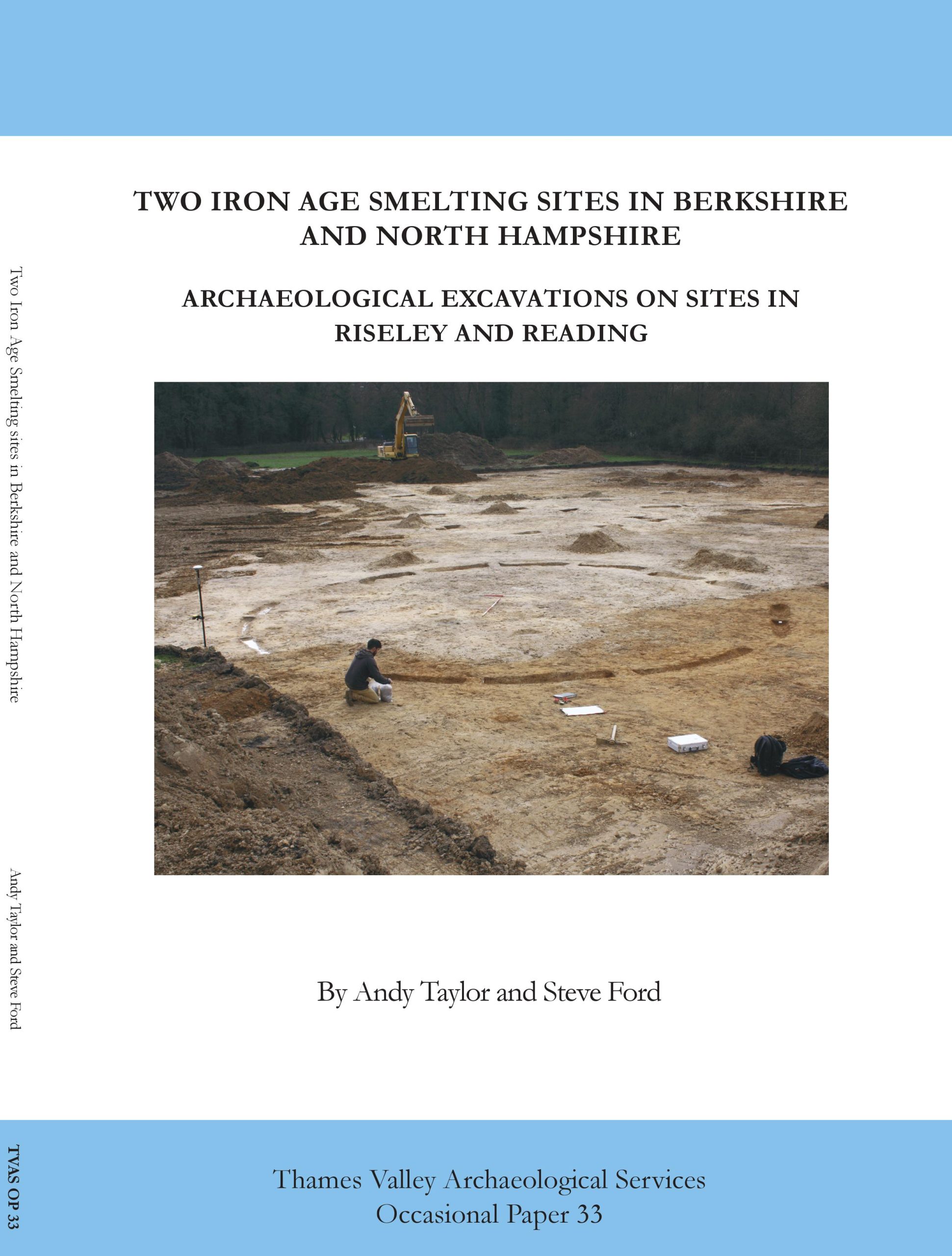
Occasional Paper 33: Two Iron Age Smelting Sites in Berkshire and North Hampshire, Archaeological Excavations on sites in Riseley and Reading
Two excavations, one in south Reading, Berkshire and a second in Riseley just over the Hampshire side of the county boundary, revealed sites predominantly of middle Iron Age date. The Riseley site was slightly more extensive, with two ring-gully structures and evidence for a small field system. Some re-use of the site also took place in early Roman times. The Reading site contained a Late Bronze Age roundhouse, Early Iron Age pit and a Roman ditch in addition to a single Middle Iron Age gully. The detailed chronology of both sites is supported by a series of radiocarbon dates.
The unifying aspect of the two sites is that in the middle Iron Age, both were involved in small-scale iron smelting using phosphate-rich (bog) iron ore. These two excavations add to a corpus of similar sites now recorded for an area broadly south and south-east of Reading encompassing parts of north Hampshire and north-west Surrey. The corpus is well documented with radiocarbon-based chronology and detailed metallurgical analysis of the slag recovered.
A final short chapter of the volume assesses the significance of these data in the wider context of the Origins, development and subsequent demise of an iron production 'industry' in this area in the Iron Age.
A4 soft cover, 49pp, illustrated throughout including 23 colour plates.
ISBN 978-1-911228-39-4
Paperback (+ PDF if requested) £13.00 (+postage and packaging)
PDF £13.00
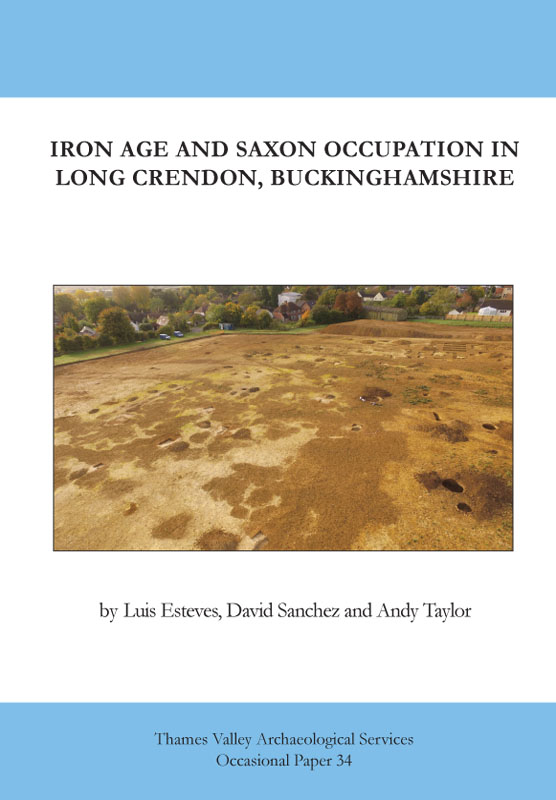
Occasional Paper 34: Iron Age and Saxon Occupation in Long Crendon, Buckinghamshire
The results of two archaeological excavations carried out in advance of development in Long Crendon in Buckinghamshire are reported in this volume. Both of the sites, not far apart on the eastern and south-eastern fringes of Long Crendon, revealed Middle and Late Iron Age occupation evidence, in the form of field boundaries, large and small pits, and including one post-built roundhouse and several four-post structures of the type normally considered to be granaries. At Madge’s Farm, a large volume of medium/small pits related to quarrying and part of a ridge and furrow field system were also uncovered. Finds included two Iron Age slingshots, which may take on added signifiance in the light of recent confirmation of the presence of a multi-vallate hillfort at the north of the modern village. On the other site, at Wainwrights, a crouched child burial is tentatively dated to the Iron Age. This site also provided evidence for early to middle Anglo-Saxon occupation. The Iron Age and Saxon chronologies are supported by radiocarbon dating.
A4 soft cover, 77pp, illustrated throughout including 22 colour plates.
ISBN 978-1-911228-37-0
Paperback (+ PDF if requested) £13.00 (+postage and packaging)
PDF £13.00

Occasional Paper 35: Later Neolithic Pits, a Bronze Age ring ditch and early Anglo-Saxon buildings at Braywick Park, Maidenhead, Berkshire
An open excavation revealed deposits that show a long but discontinuous use of the site from the later Neolithic through to the early Saxon period. Radiocarbon dates place a small cluster of pits containing Peterborough Ware pottery at the very start of the 3rd millennium BC. These are considered to represent rarely encountered occupation deposits of this period. More than a millennium later the site was used to construct one, possibly two ring ditches likely to represent now levelled Early Bronze Age burial mounds, though no burial deposits were revealed. The frequent presence of ring ditches on the gravel terraces of the Thames shows how densely used the valley was in the earlier part of the Bronze Age, despite meagre evidence for contemporary occupation sites. Finally, after another two millennia, the site was used for early Saxon occupation, in the form of six sunken-featured buildings and other features, which radiocarbon dating helped to show, were not all contemporary.
A4 soft cover, 40pp, illustrated throughout including 15 colour plates.
ISBN 978-1-911228-36-3
Paperback (+ PDF if requested) £13.00 (+postage and packaging)
PDF £13.00

Occasional Paper 36: Middle bronze Age to Middle Iron Age occupation at The Paddocks, Nutbourne, Chichester, West Sussex
The archaeological excavation revealed two clusters of features, one consisting mostly of pits (or tree-throws) and one mostly of post-holes, which appear to form at least five roundhouses. Overall there is clearly occupation on the site, probably sporadically, from the Middle Bronze Age to the Middle Iron Age. Four radiocarbon dates support the ceramic chronology. Southern English Later Bronze Age settlement displays a wide range of occupation site form. Sometimes this comprises just single roundhouses, as at Gosport or Westhampnett; sites with a greater or lesser degree of enclosure as at North Bersted or Ford Airfield, Yapton; large enclosures, ringworks or proto-hillforts; and burnt mounds as at Patchling. Another form is that of unenclosed, dense groups of pits and post-holes, lacking any obvious organized layout, as at Selsey, and further afield at Ringwood, Hampshire, Knights Farm, Berkshire and Roundhouse Farm, Wiltshire. It is to this latter group that the site at The Paddocks belongs.
A4 soft cover, 31pp, illustrated throughout including 13 colour plates.
ISBN 978-1-911228-38-7
Paperback (+ PDF if requested) £13.00 (+postage and packaging)
PDF £13.00
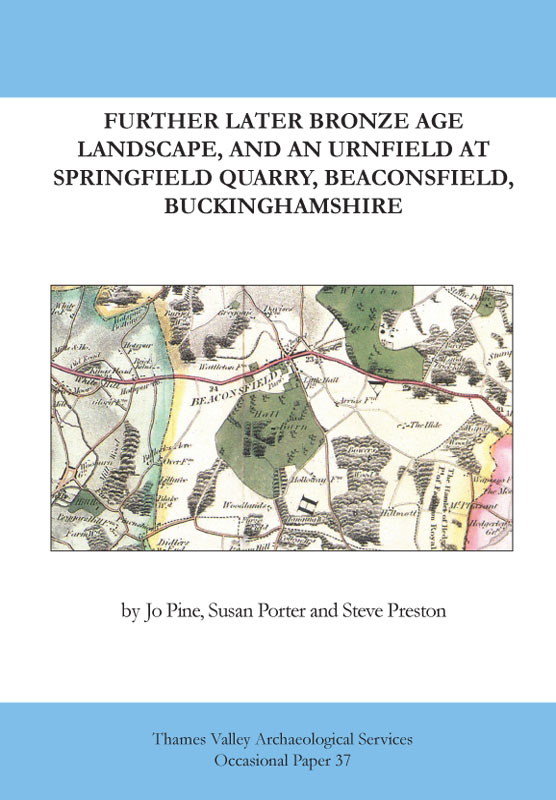
Occasional Paper 37: Further Later Bronze Age landscape, and an Urnfield at Springfield Quarry, Beaconsfield, Buckinghamshire
This volume reports on further archaeological work on the extensions to Springfield Quarry, where excavations previously published in TVAS Monograph 14, have uncovered Middle Bronze Age and Late Bronze Age/Early Iron Age landscape features. The latest work extends our knowledge of the use of this landscape, seeing the beginnings of land division, and then an expansion of that managed landscape, including two large enclosures. More significantly, it has helped refine the chronology (making much more sense of the site’s development), and added a completely new element in the form of an urnfield. The chronology of the site is supported by an extensive pottery assemblage and five radiocarbon dates. Other finds were very few and environmental remains limited.
A4 soft cover, 45pp, illustrated throughout including 13 colour plates.
ISBN 978-1-911228-40-0
Paperback (+ PDF if requested) £13.00 (+postage and packaging)
PDF £13.00
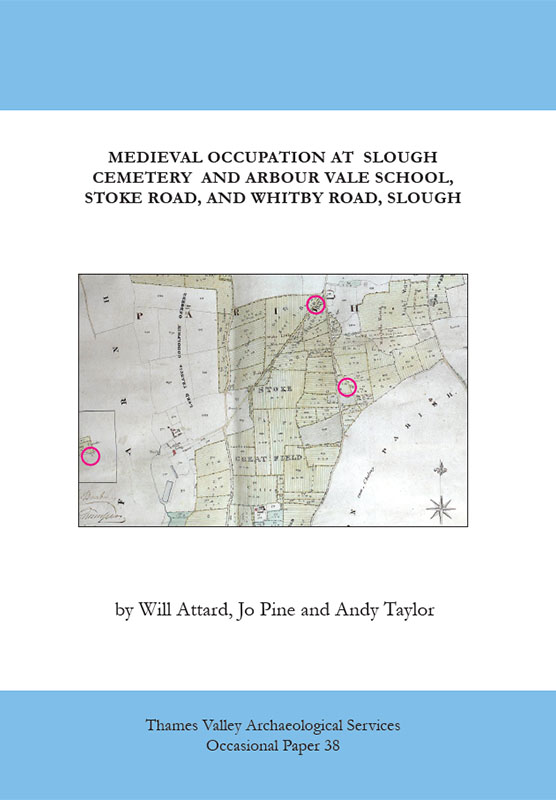
Occasional Paper 38: Medieval Occupation at Slough Cemetery and Arbour Vale School, Stoke Road and Whitby Road, Slough
This paper details the findings of two archaeological excavations undertaken at locations on the northern fringes of Slough, Berkshire (though one of the sites was just across into Buckinghamshire), as well as features from an evaluation.
On a site destined to become an extension to Slough cemetery, an area defined within a substantial boundary ditch seems to have been used to quarry brickearth in the 12th or 13th-century, the quarries then filled with domestic waste. Although finds included substantial building materials such as faced flint nodules and tile, no structural remains were present below-ground. There was evidence for a short-lived burst of blacksmithing. Pottery came from a variety of sources, suggestive of at least some wealth wherever the accompanying houses may have been.
At Arbour Vale School, just a little further south, very similar quarrying appears to date perhaps a century earlier. Here, again, there was no real evidence for a habitation other than limited disposal of domestic waste, and finds were every sparse, suggesting that this site is more likely to represent a single farm.
At Whitby Road in Slough Trading Estate, an area with little recorded archaeology, further early medieval features were revealed below a buried soil during an evaluation. The subsequent development groundworks did not expose the archaeological levels in this location and the significance of these deposits will have to await a future opportunity for study.
A4 soft cover, 53pp, illustrated throughout including 20 colour plates.
ISBN 978-1-911228-42-4
Paperback (+ PDF if requested) £13.00 (+postage and packaging)
PDF £13.00
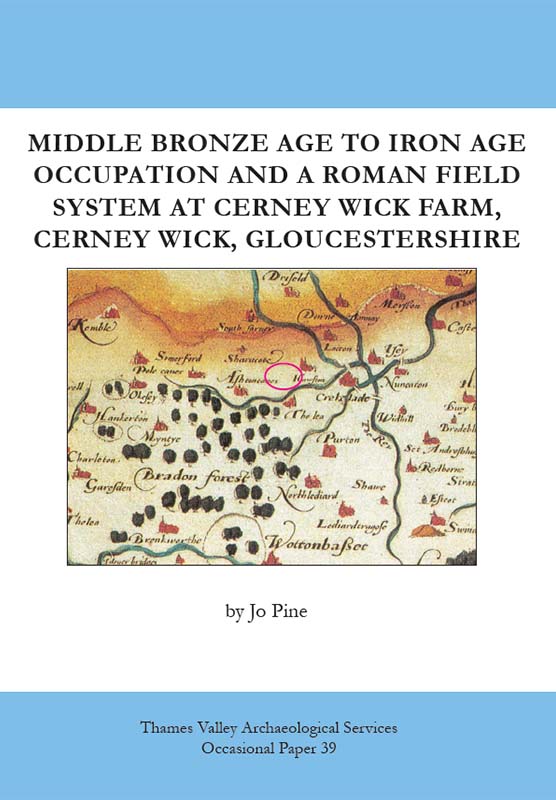
Occasional Paper 39: Middle Bronze Age to Iron Age Occupation and a Roman Field System at Cerney Wick Farm, Cerney Wick, Gloucestershire
Excavations within the Cerney Wick Farm quarry complex revealed a landscape occupied from the Middle Bronze Age through to the Post-Medieval period. The chronology of the occupation episodes is supported by radiocarbon dating. The earliest feature was a small ring ditch, dated to 1695-1604 cal BC. A small later Bronze Age settlement comprised four post-built roundhouses, pits and postholes. There is a suggestion of Later Bronze Age-Early Iron Age activity with a gully and possibly a contemporary post-built roundhouse.
In the Middle Iron Age a small farmstead was established, comprising a roundhouse and land divisions. This was replaced by a new roundhouse set within an enclosure in the Middle to Later Iron Age.
Roman occupation is sparse with a suggestion of a field system and a few boundary ditches. In the Post-Medieval period the area was intensively utilized with a trackway and water meadow system. The agricultural regime then changed with a late version of ridge and furrow overlying the water meadows.
A4 soft cover, 56pp, illustrated throughout including 14 colour plates.
ISBN 978-1-911228-43-1
Paperback (+ PDF if requested) £13.00 (+postage and packaging)
PDF £13.00
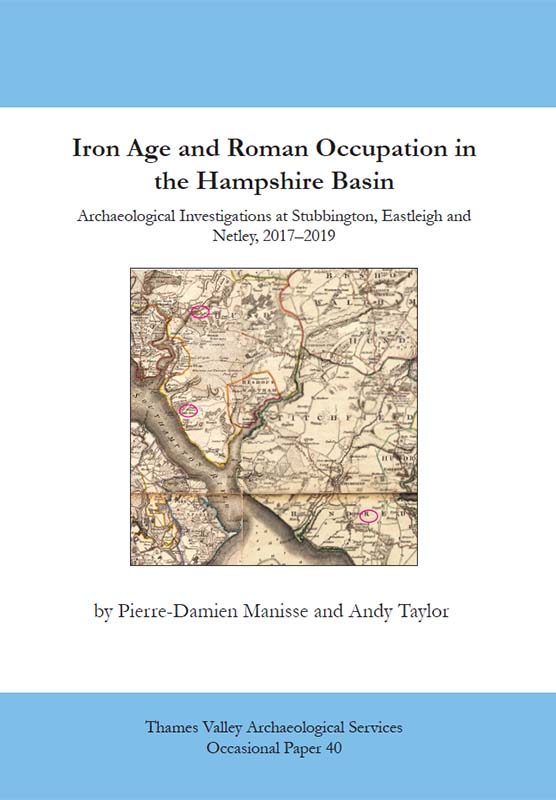
Occasional Paper 40: Iron Age and Roman Occupation in the Hampshire Basin: Archaeological Investigations at Stubbington, Eastleigh and Netley, 2017-2019
This volume presents results of investigations on three sites in an area close to the south coast in Hampshire, which has previously received relatively little archaeological investigation.
The largest of these investigations was on the line of Stubbington Bypass, where areas totalling just over 1ha were opened. Three of these areas revealed a moderate density of archaeological features, including ditches and gullies forming boundaries, rubbish pits, postholes and water holes belonging to the early Roman period. They testified to a rural occupation site and field system, that lasted for a few centuries before abandonment in the late 2nd century AD.
Two small areas excavated at Hatch Farm, Eastleigh, revealed deposits of mainly Iron Age date. A single short length of gully and residual pottery dated from the Bronze Age. The earlier part of the Iron Age was represented by a ditch which contained a small amount of slag from a smithing furnace. Subsequent Iron Age activity, perhaps more than two centuries later, is likely to represent part of an enclosed occupation site.
At Grange Road, Netley, a small open area excavation revealed part of a Middle Iron Age occupation site represented by pits and postholes with a radiocarbon date of 404-228 cal BC.
A4 soft cover, 66pp, illustrated throughout including 25 colour plates.
ISBN 978-1-911228-44-8
Paperback (+ PDF if requested) £13.00 (+postage and packaging)
PDF £13.00

Occasional Paper 41: A Sub-Roman Cemetery at Whithill Quarry Extension, Lillington, Sherborne, Dorset
This paper details the findings of a small excavation undertaken by TVAS South West in advance of quarrying, which uncovered a cemetery of some twenty inhumation burials, two of which were radiocarbon dated to the late 6th or 7th century AD. It is likely that other burials would have been located in an area already previously quarried away to the south and/or east, but the limits of the cemetery to the north and west were clearly established, albeit unmarked. The buried population included seven adult females, six adult males and seven children, all buried without grave goods (one possible exception being a finger ring) but in a tidily organized cemetery layout. Isotope analysis indicated that they grew up and lived in the region of the cemetery
A4 soft cover, 49pp, illustrated throughout.
ISBN 978-1-911228-48-6
Paperback (+ PDF if requested) £13.00 (+postage and packaging)
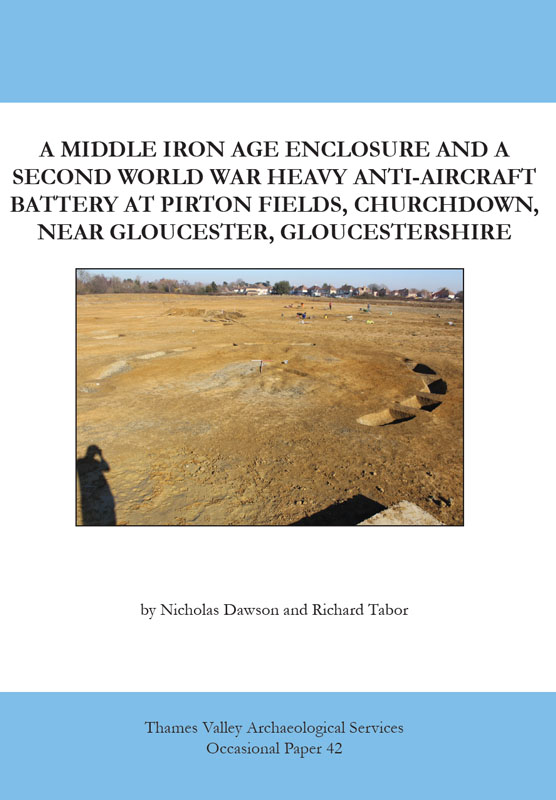
Occasional Paper 42: A Middle Iron Age Enclosure and a Second World War Heavy Anti-Aircraft Battery at Pirton Fields, Churchdown, near Gloucester, Gloucestershire
Archaeological excavation on the outskirts of Gloucester revealed evidence of episodic use of the site, from the later Bronze Age through to the 20th century. Bronze Age pits and linear features probably represent traces of occupation and a field system. This developed in the Iron Age with the inclusion of a ring gully house site and in turn was enhanced by construction of a discrete enclosure, with evidence suggesting that the subsistence economy was predominantly pastoral. Three radiocarbon dates support the Iron Age chronology. The settlement is considered to have thrived in the 5th Century BC but had gone out of use before the onset of the Late Iron Age.
The site was farmed in Roman times as a few traces of a field system were revealed, and again during the Medieval or Post-Medieval periods as evidenced by widespread ridge and furrow. The final phase of use comprised the construction and use of a Second World War anti-aircraft battery, remains of which were extant at ground level.
A4 soft cover, 49pp, illustrated throughout including 14 colour plates.
ISBN 978-911228-49-3
Paperback (+ PDF if requested) £13.00 (+postage and packaging)

Occasional Paper 43: A Middle Bronze Age Ring Ditch and Roman Settlement Enclosures at Netherhouse Copse, Hitches Lane, Fleet, Hampshire
This volume presents results of archaeological investigations on one large and several smaller areas within a site in an area close to the north-eastern border of Hampshire, which until recently had received relatively little archaeological investigation. Use of the site began in the Middle Bronze Age with the digging of ditches and a ring ditch. The ring ditch (barrow) was only 4m across and was associated with an urned cremation burial which returned a Middle Bronze Age radiocarbon date of 1214-1012 cal BC. No dated artefacts were recovered from the ring ditch. Area F revealed a pair of linear features aligned at right angles to each other, of Middle to Late Bronze Age date, containing pottery and returning two radiocarbon dates of 1256-1156 cal BC and 1111-970 cal BC. They are considered to be elements of a Bronze Age field system, but the location of any contemporary settlement remains unknown. There was then a lengthy gap until Roman use of the site which formed an agricultural settlement, as an initial enclosure which developed in at least five phases, three early Roman and two late, apparently with a break in between. The settlement is considered to have been of modest status in all phases, with no conspicuous examples of material wealth, and certainly no elaborate architecture, but the occupants were not necessarily impoverished and certainly disposed of a substantial pottery assemblage. On the basis of admittedly tentative evidence, the economy of the site is considered to have been predominantly pastoral. The results are related to recent excavations on a nearby site to the north.
A4 soft cover, 63pp, illustrated throughout including 12 colour plates.
ISBN 978-911228-50-9
Paperback (+ PDF if requested) £13.00 (+postage and packaging)

Occasional Paper 44: Excavation of Neolithic Pits, Late Bronze Age Occupation, Late Iron Age into Roman Field System and Saxon Pits at Roke Manor Farm, Shootash, Romsey, Hampshire
This volume presents the results of archaeological investigations in advance of sand and gravel extraction. The first phases of excavation revealed an extensive field system including a possible droveway, dated to the Late Iron Age-Early Roman period, into which two enclosures were incorporated. The smaller enclosure in the south-eastern quadrant was possibly contemporary with the field system but only scant dating evidence was recovered. The larger enclosure at the western edge of the excavation was securely dated to the Early Roman period. The latter was only partially uncovered by the fieldwork and it is not clear if this was an occupation site or was simply another component of the organised landscape. The fourth phase of excavation revealed the eastwards continuation of the Late Iron Age-Early Roman field system and droveway, but added unexpected new components in the form of Late Neolithic pits, a dense cluster of Late Bronze Age occupation features, and two Anglo-Saxon pits. The chronology is supported by radiocarbon dates. The final phases of extraction extended this range of features with several discrete clusters of unenclosed and only very loosely organized Late Bronze Age settlement. A substantial pottery assemblage was recovered (though very few other finds) and the chronology is again supported by radiocarbon dates centred on the 9th and 10th centuries cal BC. Shallow ditches and gullies, although undated in this area, also appear to extend the Late Iron Age or Early Roman landscape seen to the west. The most notable feature on the site is a Late Bronze Age pit which contained 22kg of pottery from at least 18 vessels, radiocarbon dated to 1125–969 cal BC. The Saxon pits, one of which dated to AD 659–729 contained iron smelting slag but no furnace was present.
A4 soft cover, 79pp, illustrated throughout including 21 colour plates.
ISBN 978-1-911228-54-7
Paperback (+ PDF if requested) £13.00 (+postage and packaging)

Occasional Paper 45: Late Neolithic, Bronze Age, Roman and Anglo-Saxon Occupation at George Green Quarry, Wexham, Slough, Buckinghamshire
A programme of archaeological fieldwork in advance of gravel extraction has revealed a range of settlement deposits of Late Neolithic, Bronze Age, Early Roman, Middle and Late Saxon dates. The chronology is supported by radiocarbon dating. The Late Neolithic was represented by a single pit and residual struck flints. A very loose cluster of poorly-dated pits may be Early Bronze Age. The Middle Bronze Age was better represented, in the form of a small cluster of postholes and pits, the latter sometimes with in-situ pots. Later Bronze Age deposits were more numerous, with four clusters of pits and postholes perhaps representing individual occupation foci. There was still no evidence for enclosure nor other land division. Although some of the pottery recovered appears to be of Middle Iron Age date, no deposits of this period were recorded and only into the 1st century AD was there evidence of renewed settlement, whose form mirrors that of the preceding periods. The Roman activity ceased in the 2nd century AD with very few sherds of later Roman pottery present; a disruption frequently observed in the low-status rural settlement record of the region. The final significant activity on the site was a dispersed group of deposits of Saxon date. A Middle Saxon phase was represented by a small cluster of pits surrounding a well. Four hundred metres to the north, a second cluster of features including a post-built structure was tentatively assigned to a Late Saxon phase. A few sherds of Medieval pottery, ridge and furrow and post-medieval boundaries complete the summary of the deposits recorded.
A4 soft cover, 87pp, illustrated throughout including 17 colour plates.
ISBN 978-1-911228-57-8
Paperback (+ PDF if requested) £13.00 (+postage and packaging)
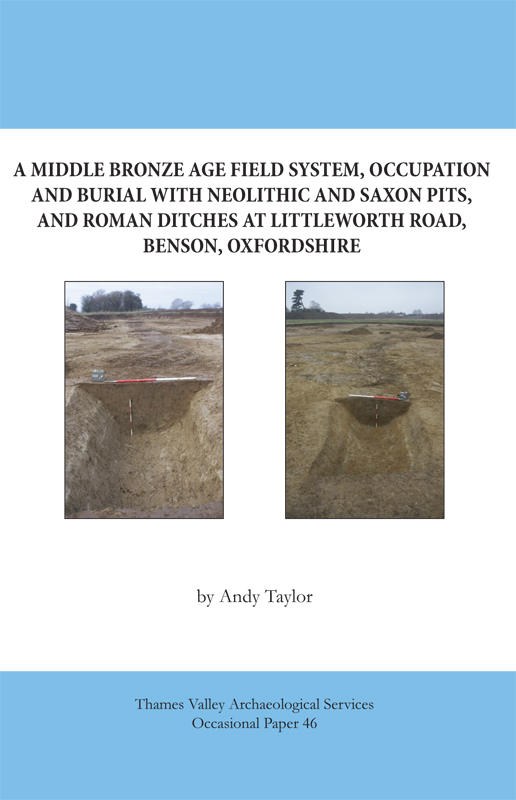
Occasional Paper 46: A Middle Bronze Age field system, occupation and burial with Neolithic and Saxon pits, and Roman ditches at Littleworth road, Benson, Oxfordshire
The fieldwork examined an extensive spread of archaeological deposits mostly assigned a Middle Bronze Age date. In particular, a large area of enclosed landscape (field system) has been closely dated to the Middle Bronze Age by a series of four radiocarbon dates suggesting it was in use from about 1400-1200 BC. The field system was unusually rich in finds of pottery and animal bone, the latter including horse, an animal likely to have been of special status at this time. A bronze side-loped spearhead was also recovered. The field system is thought to be indicative of the presence of an elite in society. Despite the volume of artefacts, deposits representing settlement activity were few. The extensive examination of a contiguous area has been of particular significance in understanding the nature, layout and chronology of the field system, a perspective unobtainable from smallscale interventions. A few Neolithic and Early Bronze Age pits were recorded along with a few clusters of Middle Bronze Age occupation features that predated the field system. Finally, a few ditches of Roman date were recorded along with a single large Anglo-Saxon pit or waterhole, radiocarbon dated to the 6th century AD. There was almost no correspondence of the features here with those excavated previously on the adjacent site to the south, in terms either of landscape organization or of chronology.
A4 soft cover, 74pp, illustrated throughout including 16 colour plates.
ISBN 978-1-911228-58-5
Paperback (+ PDF if requested) £13.00 (+postage and packaging)
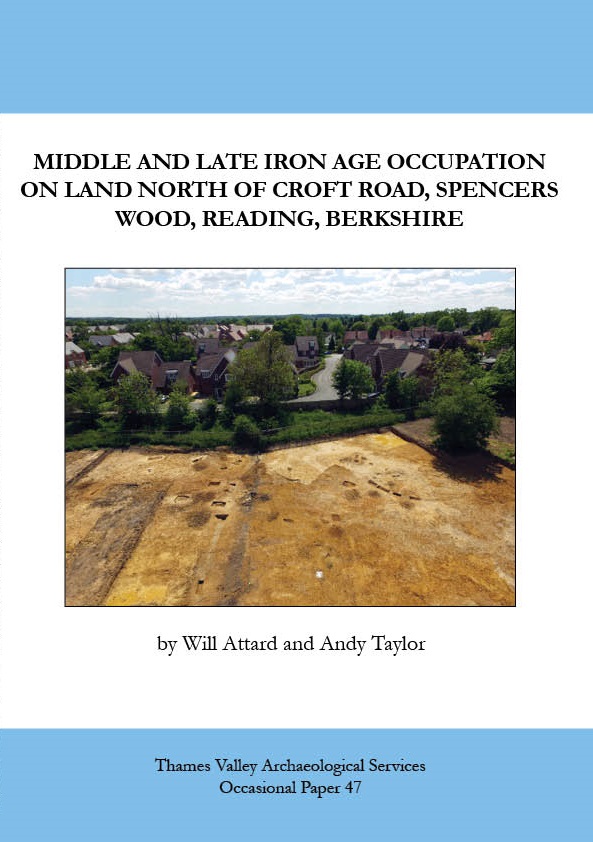
Occasional Paper 47: Middle and Late Iron Age Occupation on Land North of Croft Road, Spencers Wood, Reading, Berkshire
This volume details the archaeological excavation in advance of a develoopment to the south of Reading in Berkshire, of a Middle to Late Iron settlement comprising a round house and adjacent boundaries. Two main phases of activity were represented, dating from the 4th to the 1st century BC. Only very small quantities of finds were recovered but the pottery chronology is supported by six radiocarbon dates. Faunal remains did not survive but an extensive programme of soil sampling revealed no charred arable remains, which might be taken to indicate a pastoral economy. Of some note are two ball-like objects of fired clay, plausibly interpreted as slingshots. A waterhole also thought to have been constructed in the Middle Iron Age contained preserved organic remains and remained in use into early Roman times (confirmed by a radiocarbon date, as there was very little Roman pottery on the site). The waterlogged remains from the fills of the waterhole indicated a locally open environment but with mature oak woodland nearby. As with many Middle to Late Iron Age rural settlements, the site was abandoned before Roman influecnce came to be widely felt. The presence here of securely dated Middle Iron Age fields associated with a settlement adds to a surprisingly small corpus of such evidence for the region.
A4 soft cover, 32pp, illustrated throughout including 13 colour plates.
ISBN 978-1-911228-59-2
Paperback (+ PDF if requested) £13.00 (+postage and packaging)

Occasional Paper 48: Neolithic and Bronze Age Pits and a Late Iron Age Linear Ditch at Salisbury Road, Hungerford, West Berkshire
A programme of archaeological fieldwork in advance of a housing development at
Salisbury Road, Hungerford, revealed prehistoric features dispersed widely across the
site. The excavation investigated a small cluster of Earlier Neolithic pits along with three
isolated pits of similar date, a cluster of Late Neolithic pits, Bronze Age activity and
a linear ditch of Late Iron Age to Roman date. One Early Neolithic pit was especially
rich in finds, with close to 2000 stuck flints, and sherds of pottery from at least eleven
vessels. The prehistoric chronology is supported by radiocarbon dates. The survival of
mollusc shells provided information on the palaeoenvironment in the Early Neolithic
and from the Late Iron Age/Early Roman period up to the present day. A notable find
was a Roman iron lamp from the linear ditch. The ditch seems to have taken several
centuries to fill in completely.
A4 soft cover, 39pp, illustrated throughout including 12 colour plates.
ISBN 978-1-911228-59-2
Paperback (+ PDF if requested) £13.00 (+postage and packaging)
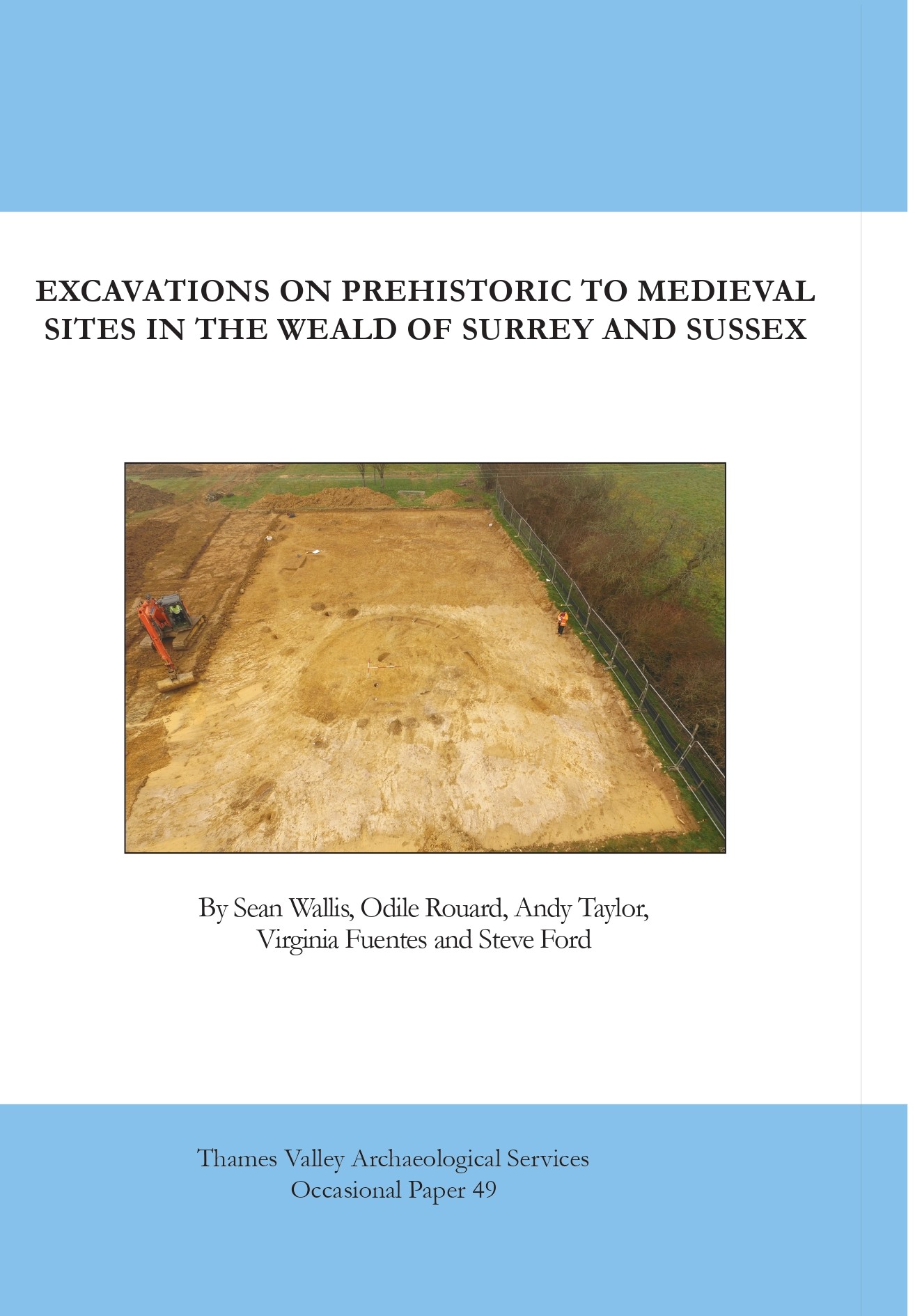
Occasional Paper 49: Excavations on Prehistoric to Medieval
Sites in the Weald of Surrey and Sussex
Small archaeological excavations on sites in Cranleigh, Herstmonceux, Alfold,
Crowborough, Icklesham, East Grinstead, Ringmer and Plumpton Green are reported
in this volume. They have little in common except to demonstrate that the notion that
The Weald across Surrey, Sussex and Kent was uninhabited and largely unexploited
(except for iron production) for most of its past requires revision. While the evidence
might amount to only small, scattered settlements, the sites documented here span
the Middle and Late Bronze Age, Early, Middle and Late Iron Age, Early Roman
and Medieval periods and include not only settlement but also burial and evidence
for pottery production alongside the more expected iron production, and in one case
(Plumpton Green) clear evidence for arable crop production indicating that the land
was also being cleared and farmed. Generally small finds assemblages are supplemented
by radiocarbon dates for the earlier periods.
A4 soft cover, 162pp, illustrated throughout including 67 colour plates.
ISBN978-1-911228-63-9
Paperback (+ PDF if requested) £13.00 (+postage and packaging)
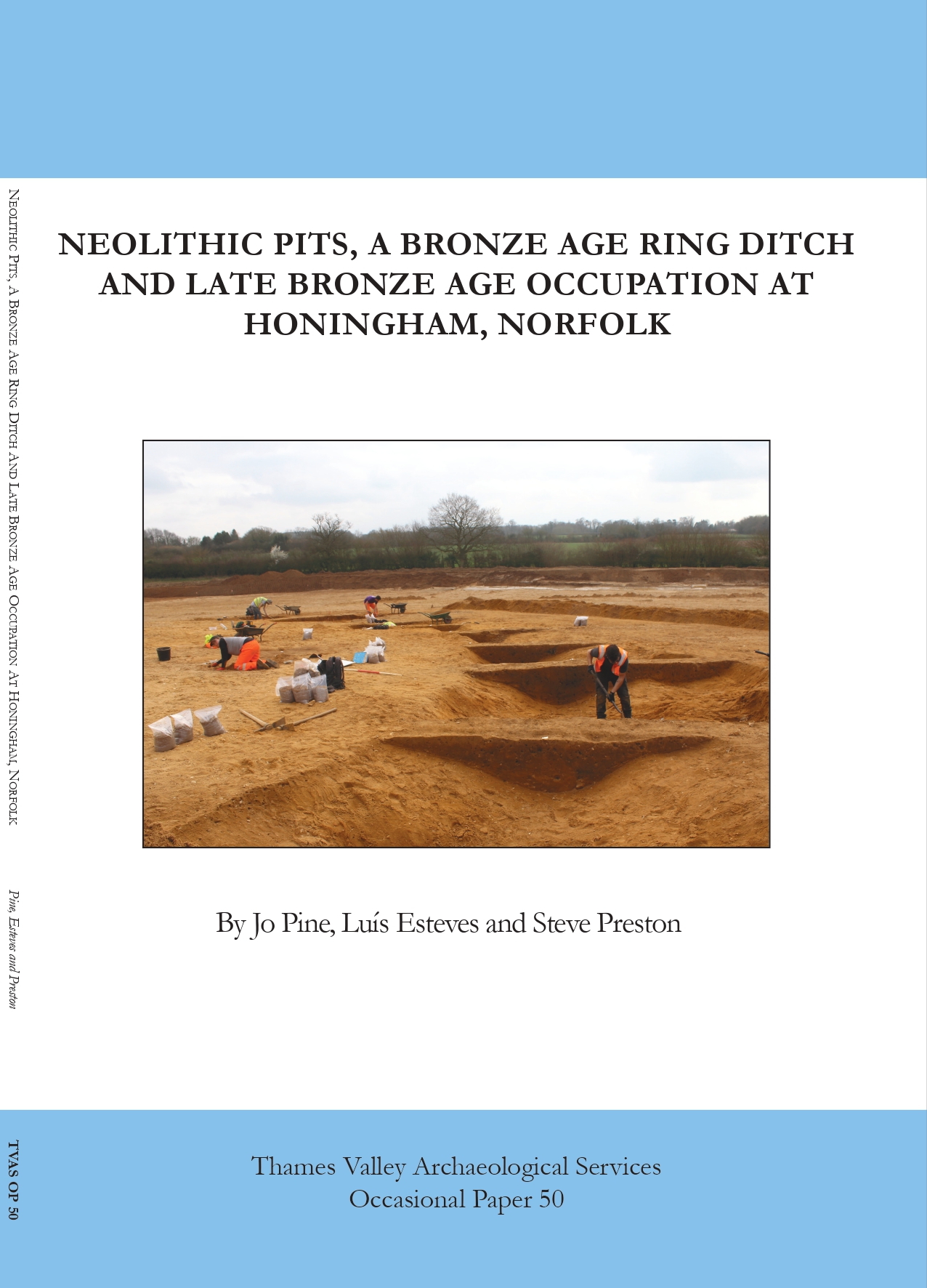
Occasional Paper 50: Neolithic Pits, A Bronze Age Ring Ditch and Late Bronze Age Occupation at Honingham, Norfolk
Archaeological excavations on two adjacent sites in Honingham are reported in this
volume. A series of pits containing deliberately placed deposits seems to span the
Middle to Late Neolithic, with both Peterborough ware and Grooved ware strongly
represented, indicating an early and persistent ritual significance for the location.
This was emphasized when a round barrow was constructed in the early Bronze Age
(although there was no evidence of an accompanying burial). The barrow’s ring ditch,
however, remained open to receive a human cremation burial in the middle Bronze
Age and was probably also still visible in the late Bronze Age when the use of the
area shifted to settlement. In the late Iron Age, or very early in the Roman period,
field boundaries were laid out, at least one of which was replaced on a couple of
occasions into the early and middle Roman period. The two sites produced a significant
prehistoric pottery assemblage, although other finds, and environmental data, were
sparse. The chronology is supported by a series of radiocarbon dates.
A4 soft cover, 72pp, illustrated throughout including 27 colour plates.
ISBN978-1-911228-64-6
Paperback (+ PDF if requested) £13.00 (+postage and packaging)

Occasional Paper 51:Bronze Age Funerary Monuments and Late Roman Enclosures at Downton Manor Farm, Milford on Sea, Hampshire
Archaeological excavation in advance of quarrying revealed features ranging in date
from Bronze Age to modern. The most significant results are three round barrows with
an associated cremation cemetery, firmly dated to the 15th to 13th centuries BC, with
a substantial pottery assemblage and a radiocarbon chronology. Other finds, however,
were very few.
The other significant phase of site use saw a rectilinear ditched enclosure with
associated paddocks, representing a small Roman farmstead which came into being
no earlier than the late 3rd century AD and continued into the 4th century before
being abandoned. It is possible that the economy of the site was dominated by animal
husbandry. This site is unusual in being founded relatively late in the period, when there
is more evidence for sites being abandoned than for new foundations.
A4 soft cover, 51pp, illustrated throughout including 27 colour plates.
ISBN978-1-911228-66-0
Paperback (+ PDF if requested) £13.00 (+postage and packaging)

Occasional Paper 52: Late Saxon, Medieval and Early Post-Medieval Occupation at 11-16 St Martin's Street, Wallingford, Oxfordshire
This volume presents the results from archaeological investigations carried out betwen 2017
and 2020 in advance of development on two adjacent sites in the centre of Wallingford
which revealed a sequence of deposits indicating almost continuous occupation from late
Saxon times until the present. At 11-12 St Martin’s Street, a mitigation strategy was drawn
up to preserve in situ the majority of archaeological deposits by foundation design, and only
small areas requiring deeper groundworks were excavated. At 13–16 St Martin’s Street, more
of the site had to be excavated. The earliest features (probably 10th to 11th century AD)
included rubbish pits and buildings with cellars, and remarkably similar landuse continued
through the 12th to 14th centuries. There is less evidence for 15th-century occupation but
this may have been removed by the early post-medieval remodelling which probably saw
the site in use as a garden. The later post-medieval period saw the site once more built
on. The site’s assemblage of animal bones sheds light on the diet of the inhabitants in the
earlier periods, and provides some evidence for horn-working and skin processing. While
the other finds recovered point to a fairly low-status urban site in all phases, there are hints
from the animal bones that the later Saxon inhabitants may have been more affluent.
A4 soft cover, 109pp, illustrated throughout including 24 colour plates.
ISBN978-1-911228-69-1
Paperback (+ PDF if requested) £13.00 (+postage and packaging)
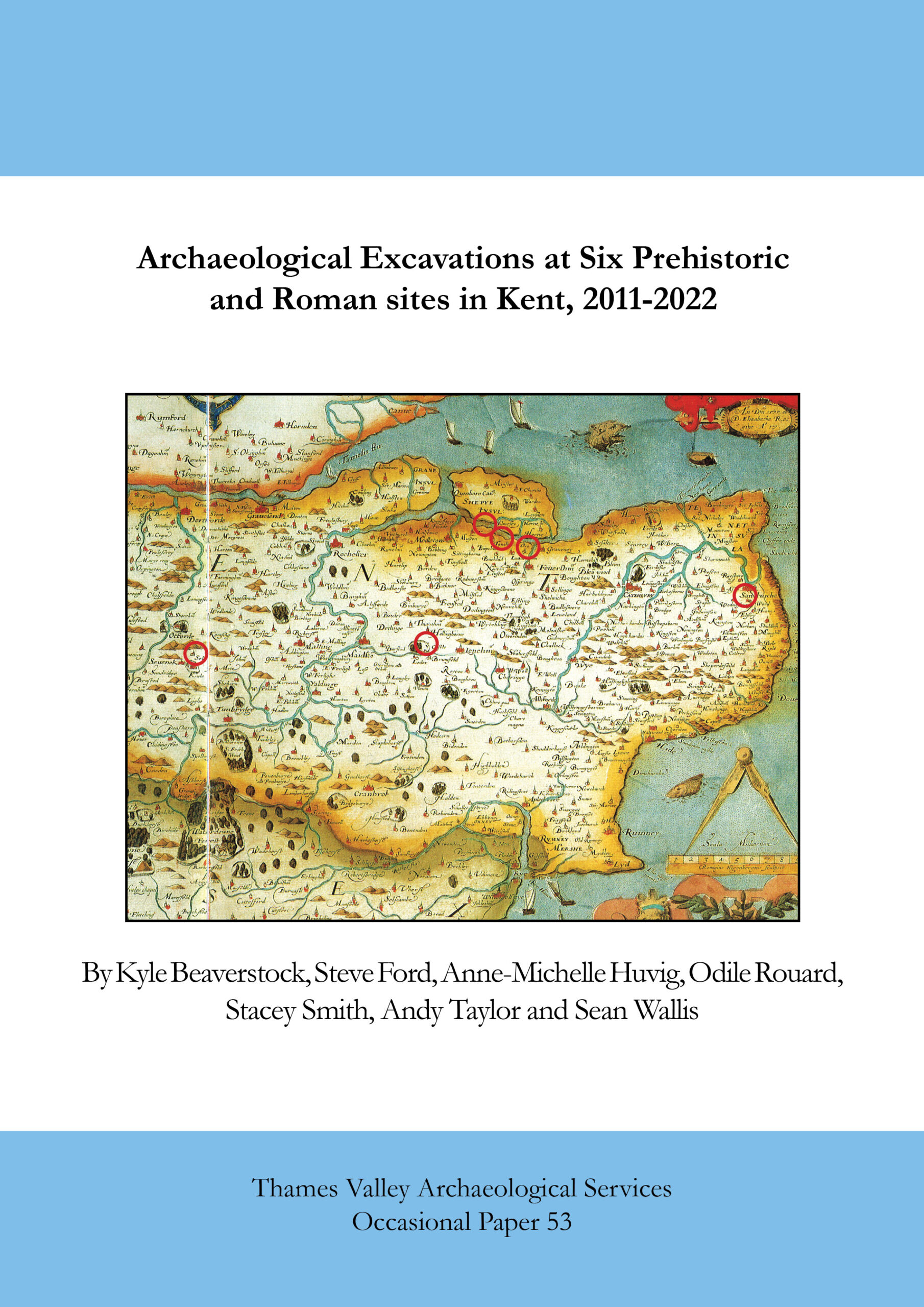
Occasional Paper 53: Archaeological Excavations at Sic Prehistoric and Roman sites in Kent, 2011-2022
This volume reports on six medium and small-sized excavations of archaeological sites in central and northern Kent.
From west to east: the largest site covered here was at Sevenoaks Quarry which revealed Middle and Late Bronze Age occupation including a Middle Bronze Age ring gully and pits containing pyre material, a small Iron Age ‘banjo’ enclosure and separate ring gully house, with a small rectangular enclosure or pen of early Roman date. Two Palaeolithic handaxes were also notable finds.
At Barty Farm, Bearsted east of Maidstone, the deposits mainly represented Middle and Late Bronze Age occupation, including several cremation burials together with placed deposits of whole ceramic vessels, along with some Roman boundary features.
Three sites add to the dense range of excavations just to the north of Sittingbourne. At Iwade Quarry, this phase of fieldwork mainly revealed Middle-Late Bronze Age occupation, a field system and a small barrow (ring ditch) cremation cemetery. At both Grovehurst Farm and Bapchild Quarry, more Middle and/or Late Bronze Age occupation was accompanied by further landscape organization. Late Neolithic Grooved Ware pits at Grovehurst Farm were an unusual discovery for the region.
The final site, at Woodnesborough Road, south-west of Sandwich, partially revealed an Iron Age enclosure and landscape organization and a single isolated Saxon pit.
The chronologies for each site are supported by a programme of radiocarbon dating. Sporadic but persistent finds of Mesolithic flints were also notable on most of these sites. Overall, this fieldwork has added to the already large corpus of sites, especially in the north Sittingbourne area, which reinforce the view that this region was not only densely settled by the later Bronze Age but included a landscape of field systems, seemingly arranged on an ad hoc basis, in contrast to the large, extensive and organized Bronze Age landscapes of other regions.
A4 soft cover, 211pp, illustrated throughout including 82 colour plates.
ISBN 978-1-911228-77-6
Paperback (+ PDF if requested) £17.00 (+postage and packaging)
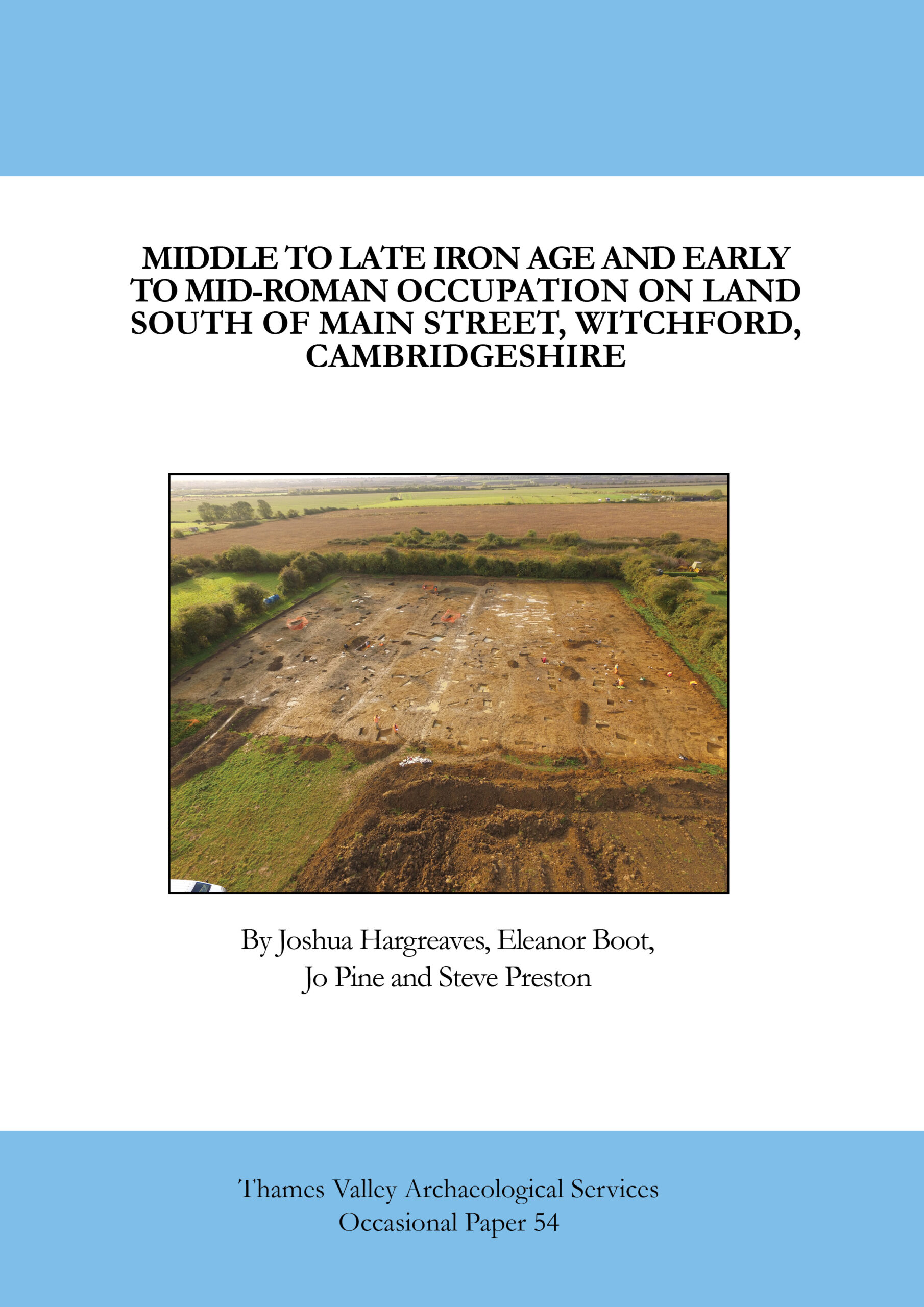
Occasional Paper 54: Middle to Late Iron Age and Early to Mid-Roman Occupation on Land South of Main Street, Witchford, Cambridgeshire
Archaeological excavation of a small area in advance of development revealed archaeological features chiefly spanning the middle Iron Age to early Roman periods, with slight traces of earlier and later land use. Elements of especial interest include ten penannular gully roundhouses, possibly accompanied by field systems; a large square enclosure of the late Iron Age to early Roman transitional period; and later Roman landscape organization (a trackway and a lazy bed system). A series of radiocarbon dates strongly suggests that at least three of the roundhouses were in contemporary use, and it is possible that most of the others could have been also, with obvious implications for any assessment of population density in the Iron Age. The Later Iron Age to early Roman period provided no positive evidence for occupation structures other than a well but the quantity of finds suggests that the site was occupied, presumably by a non-earthfast building. Abandonment seems to have followed by the end of the 1st century AD, and there is then a gap before what appears to be a return to late Roman agricultural use.
A4 soft cover, 79pp, illustrated throughout including 23 colour plates.
ISBN978-1-911228-78-3
Paperback (+ PDF if requested) £13.00 (+postage and packaging)
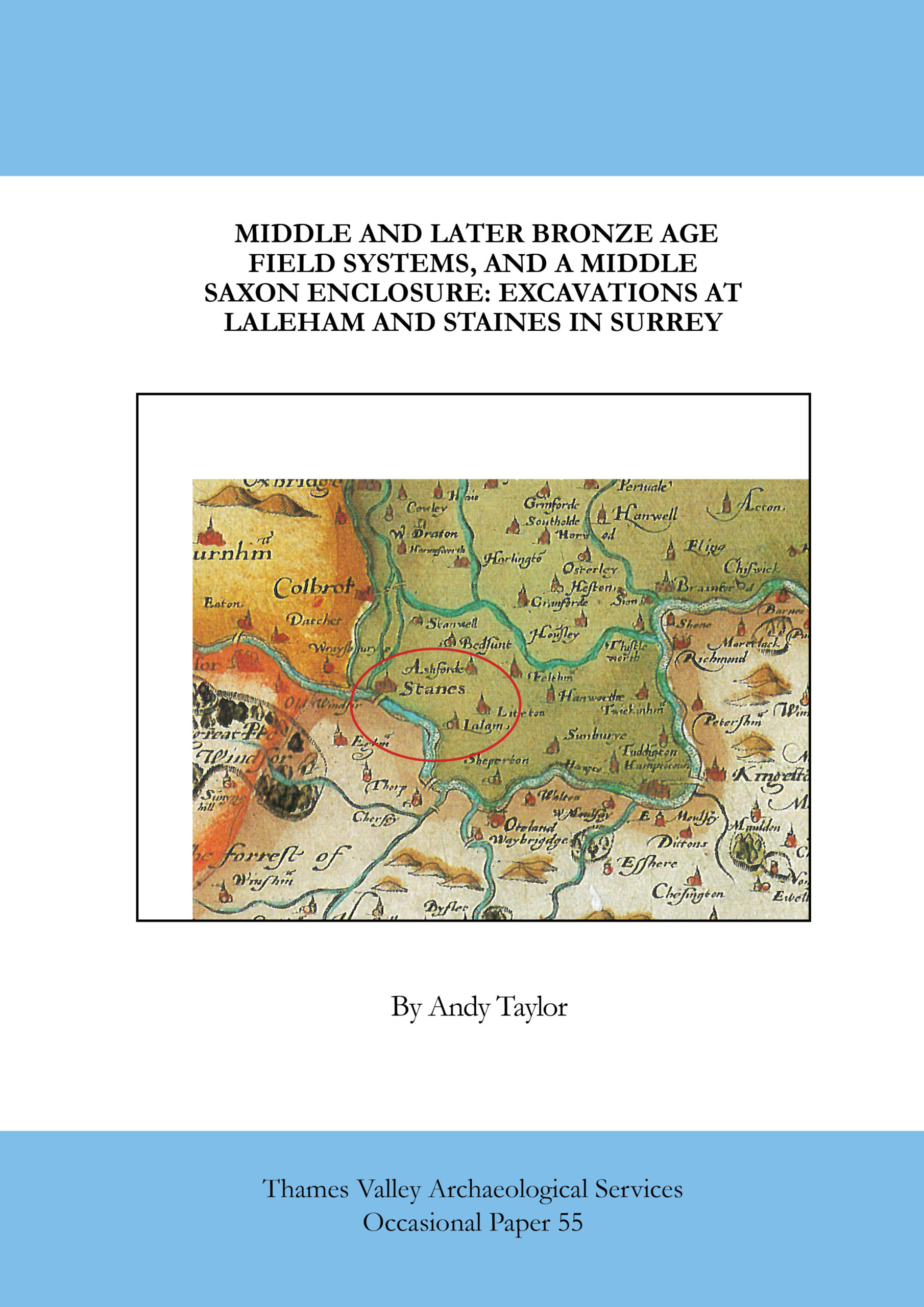
Occasional Paper 55: Middle to Later Bronze Age Field Systems, and a Middle Saxon Enclosure: Excavations at Laleham and Staines in Surrey
At Manor Farm, Laleham, archaeological excavation revealed part of a Middle Bronze Age field system with associated waterholes. Contemporary occupation deposits were also revealed but were typically slight and dispersed. The site chronology is supported by 6 radiocarbon dates. The radiocarbon chronology and pottery suggests site use continued just into the Late Bronze Age before ceasing.
The second excavation at Moor Lane, Staines, revealed a Later Bronze Age field system, a post-built roundhouse, waterhole, pits and postholes; and at least three phases of Saxon occupation. The chronology is again supported by radiocarbon dating (somewhat at odds with the ceramic evidence for both periods) but other finds were few. A moderately large assemblage of animal bone provides evidence for the exploitation of animals in the Saxon phases.
A4 soft cover, 89pp, illustrated throughout including 25 colour plates.
ISBN 978-1-911228-86-8
Paperback (+ PDF if requested) £15.00 (+postage and packaging)
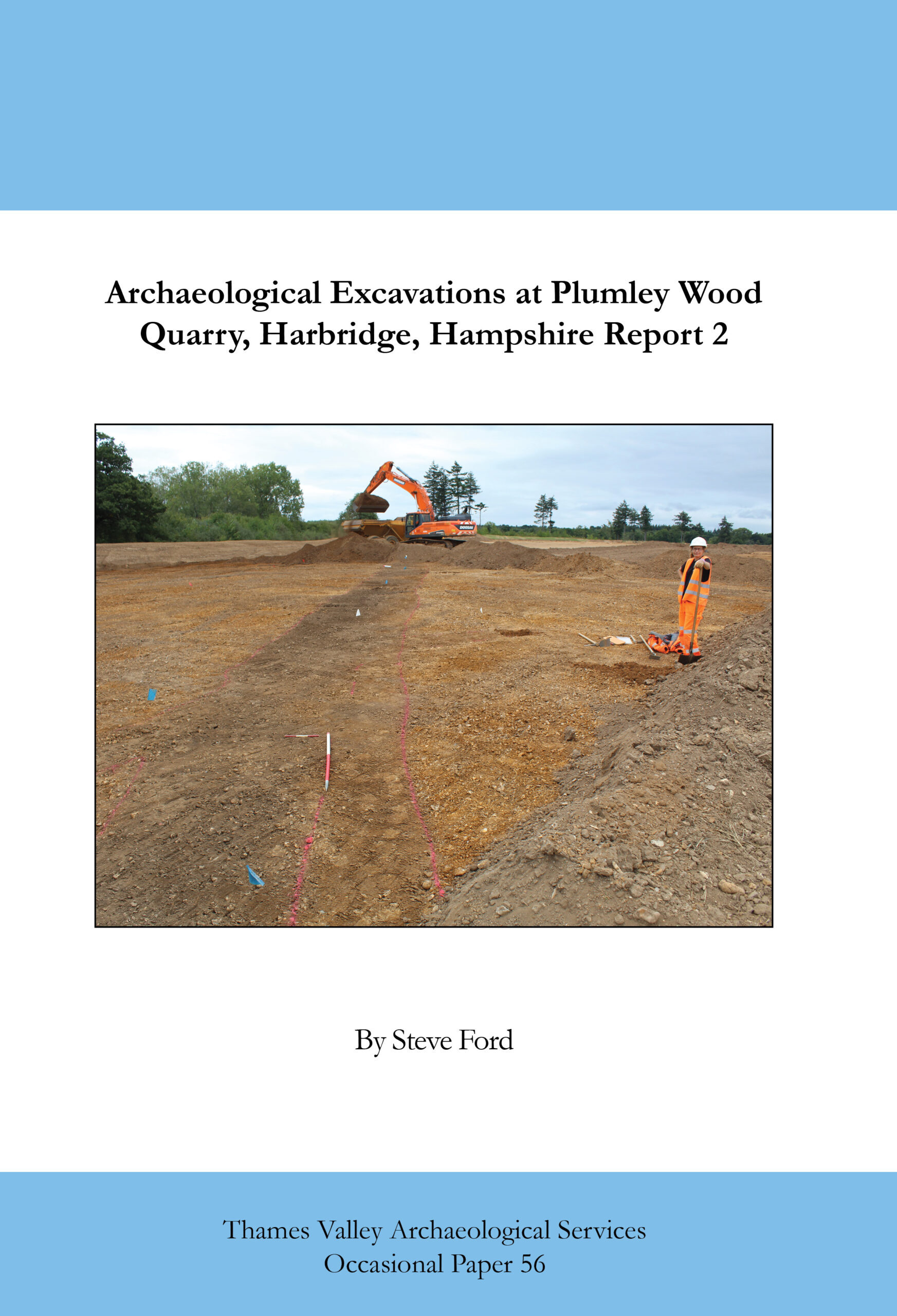
Occasional Paper 56: Archaeological Excavations at Plumley Wood Quarry, Harbridge, Hampshire Report 2
This report documents the results of further fieldwork in advance of mineral extraction at Plumley Wood Quarry. The fieldwork has described landuse of an area of the higher Avon gravel terrace which contrasts with that recorded for the terrace edge or the valley floor of the valley. The first report documented a dense enclosed settlement complex originating in the Middle Iron Age and continuing up to the end of the Roman period and which was also notable for the presence of pottery kilns producing distinctive ‘New Forest Ware’. The subsequent phases of extraction (1b-9) to date have revealed more modest volume of deposits mainly comprising later Bronze Age occupation and burial, and land management in Medieval times. A few deposits of Neolithic and Middle Iron Age date were also recorded. Small quantities of Roman pottery and several linear features might also indicate the presence of fields of Roman date but the pattern is very fragmentary. Collections of struck flint from the topsoil stripping includes material of Upper Palaeolithic, Mesolithic and Neolithic date indicating activity in these periods and which probably also represents phases of occupation when few below ground features are dug for eventual discovery by conventional archaeological techniques
A4 soft cover, 65pp, illustrated throughout including 13 colour plates.
ISBN 978-1-911228-85-1
Paperback (+ PDF if requested) £13.00 (+postage and packaging)
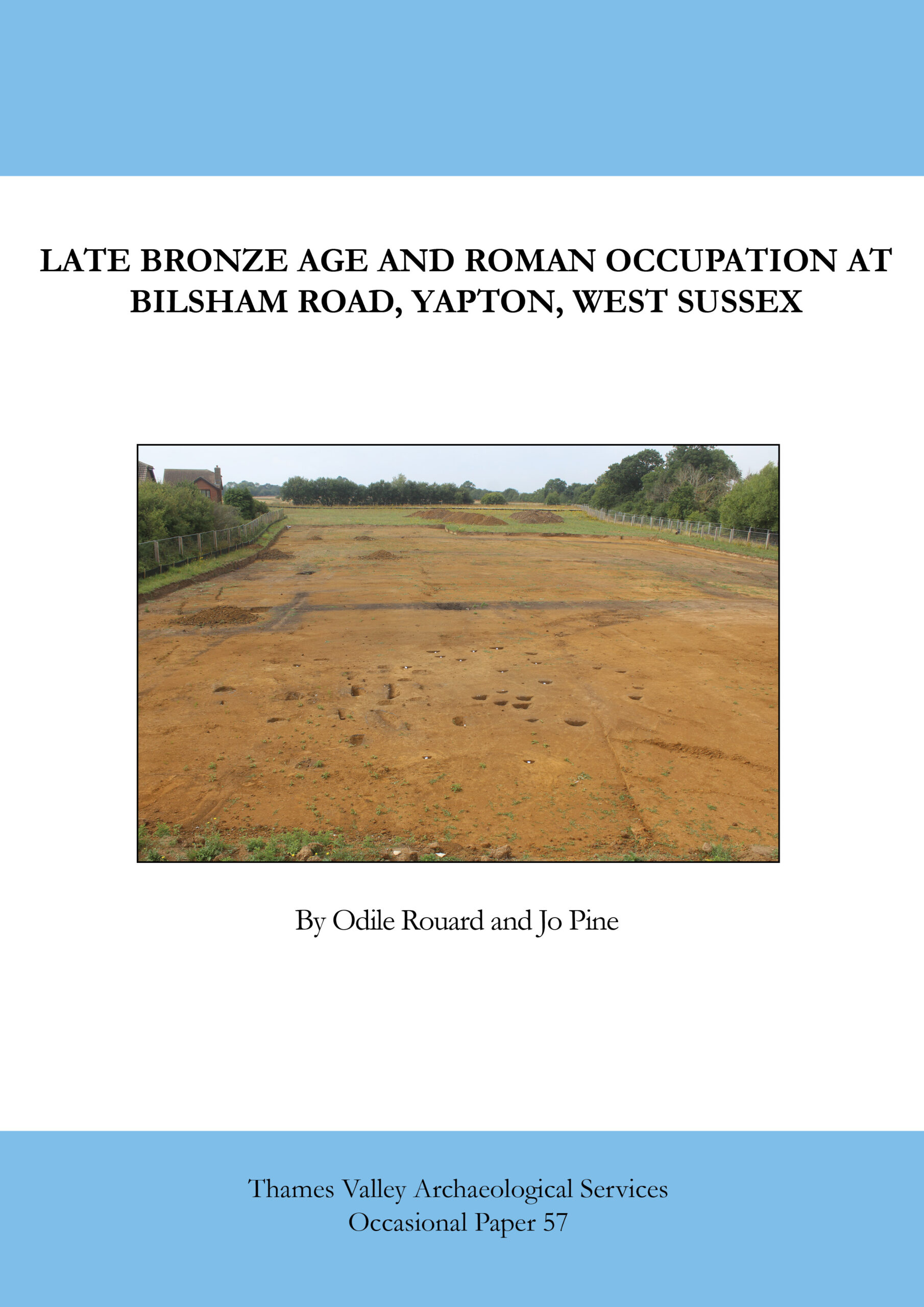
Occasional Paper 57: Late Bronze Age and Roman Occupation at Bilsham Road, Yapton, West Sussex
An archaeological excavation of two small areas in advance of housing development on the edge of Yapton revealed landuse and occupation from two main periods: Bronze Age and Roman. Postholes containing middle to late Bronze Age pottery formed a fenceline and a roundhouse, the latter radiocarbon dated to 1219–1046 cal BC. More doubtfully a single ditch may also belong to this phase. The Roman period saw several sub-phases of site use, from a low-intensity beginning in the late 1st or early 2nd century, which continued into the early 3rd, growing to more substantial settlement around AD250–300 with an enclosure complex and finds-rich midden. Although no building could be identified, the glass and ceramic building materials (including box-flue tiles) as well as the (relatively) high proportion of fineware pottery suggest a Roman building of some substance in the near vicinity. There is little on the site that suggests it was still occupied into the 4th century (just a single unstratified coin), but even use into the late 3rd century is unusual along this part of the coast.
A4 soft cover, 76pp, illustrated throughout including 23 colour plates.
ISBN 978-1-911228-88-2
Paperback (+ PDF if requested) £13.00 (+postage and packaging)
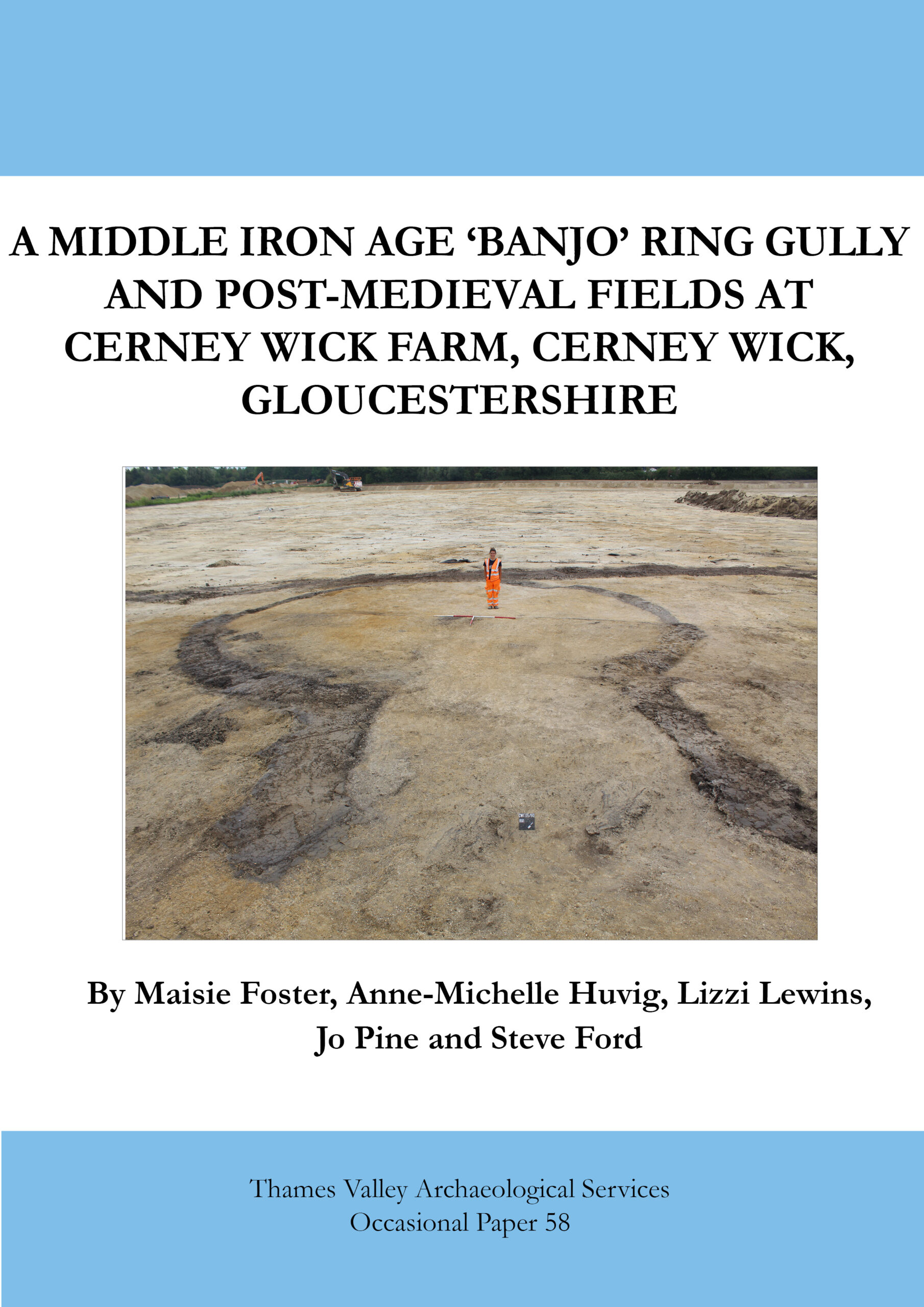
Occasional Paper 58: A Middle Iron Age 'Banjo' Ring Gully and Post-Medieval Fields at Cerney Wick Farm, Cerney Wick, Gloucestershire
This volume describes the archaeological excavation of c. 22.5ha of land in advance of a further phase of mineral extraction at Cerney Wick Quarry. The fieldwork revealed an extensive organized landscape, for the most part dating to two very distinct eras. First, two small Middle Iron Age sites were recorded. One consisted of a seemingly isolated ‘banjo’ ring gully radiocarbon dated to the 6th-3rd centuries BC. The other site was more extensive but only partially exposed and yielded pottery dated to the Middle Iron Age. A few sherds of Roman pottery and a 2nd-century AD coin point to some Roman activity on the site, but with no convincing cut features of this date.
The majority of the features comprise Post medieval trackways, field boundaries and gullies some of which might be water meadow or drainage features. These features are poorly dated but with at least 3 phases of activity pre-dating the Enclosure map of 1814 and subsequent Ordnance Survey maps.
A4 soft cover, 55pp, illustrated throughout including 21 colour plates.
ISBN 978-1-911228-87-5
Paperback (+ PDF if requested) £15.00 (+postage and packaging)